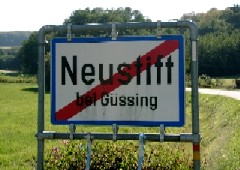|
The
|
||||||||||||||||||||||||||||||||||||||||||||||||||||||||||||||||||||||||||||||||||||||||||||||||||||||||||||||||||||
THE BURGENLAND BUNCH NEWS - No. 228 January 31, 2013, © 2013 by The Burgenland Bunch All rights reserved. Permission to copy excerpts granted if credit is provided. Editor: Thomas Steichen (email: tj.steichen@comcast.net) Our 17th Year. The Burgenland Bunch Newsletter is issued monthly online. It was founded by Gerald Berghold (who retired Summer 2008 and died in August 2008). |
||||||||||||||||||||||||||||||||||||||||||||||||||||||||||||||||||||||||||||||||||||||||||||||||||||||||||||||||||||
Current Status Of The BB: * Members: 2124 * Surname Entries: 7103 * Query Board Entries: 5077 * Staff Members: 17 |
||||||||||||||||||||||||||||||||||||||||||||||||||||||||||||||||||||||||||||||||||||||||||||||||||||||||||||||||||||
This newsletter concerns: 1) THE PRESIDENT'S CORNER 2) MARRIAGE DISPENSATIONS 3) A BURGENLÄNDER GOES HOME (by Ann Leitgeb Green) 4) NEUSTIFT BEI GÜSSING 5) ETHNIC COLORING & MIGRATION TO BURGENLAND 6) HISTORICAL BB NEWSLETTER ARTICLES: HISTORY OF POPPENDORF (by Fritz Königshofer) 7) ETHNIC EVENTS 8) BURGENLAND EMIGRANT OBITUARIES (courtesy of Bob Strauch) |
||||||||||||||||||||||||||||||||||||||||||||||||||||||||||||||||||||||||||||||||||||||||||||||||||||||||||||||||||||
1) THE PRESIDENT'S CORNER (by Tom Steichen)  Concerning
this newsletter, after the Bits and Pieces below in my
President's Corner, we get down to full length articles starting with one on
Marriage Dispensations. This is a topic I've always had a passing curiosity about but
had never taken time to look at seriously. However, the right motivation arrived this month,
so I have finally resolved my and, hopefully, your curiosity. Article 3, A Burgenländer
Goes Home, is a trip report / travel blog by Ann Leitgeb Green. Follow her as
she discovers the glories of Vienna and the nostalgia of "home." Article 4 is the result of a
request: Frank Nikischer expressed his interest in hearing more about his ancestral
village, Neustift Bei Güssing; I took up the challenge. We follow that with a
two-part article arising out of a member exchange. So Article 5 involves Ethnic Coloring
& Migration to Burgenland, though these topics are somewhat in conflict for this
member: that is, the coloring did not appear to match the presumed migration (but there was no
reason they should!). Concerning
this newsletter, after the Bits and Pieces below in my
President's Corner, we get down to full length articles starting with one on
Marriage Dispensations. This is a topic I've always had a passing curiosity about but
had never taken time to look at seriously. However, the right motivation arrived this month,
so I have finally resolved my and, hopefully, your curiosity. Article 3, A Burgenländer
Goes Home, is a trip report / travel blog by Ann Leitgeb Green. Follow her as
she discovers the glories of Vienna and the nostalgia of "home." Article 4 is the result of a
request: Frank Nikischer expressed his interest in hearing more about his ancestral
village, Neustift Bei Güssing; I took up the challenge. We follow that with a
two-part article arising out of a member exchange. So Article 5 involves Ethnic Coloring
& Migration to Burgenland, though these topics are somewhat in conflict for this
member: that is, the coloring did not appear to match the presumed migration (but there was no
reason they should!).The remaining articles are our standard sections: Historical Newsletter Articles, and the Ethnic Events and Emigrant Obituaries sections. So I start with some bits and pieces for you: The Happy Austrians: (Frank Paukowits shared this with me.) 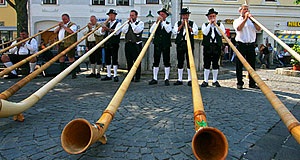 Thinking
of relocating? Want to be bold and pick up your roots and move to another country? Maybe
Austria should be one of the places you consider. Thinking
of relocating? Want to be bold and pick up your roots and move to another country? Maybe
Austria should be one of the places you consider.Each year the Organization for Economic Co-operation and Development (OECD) rates countries according to how happy the people are. The rating is based on interviews with people and metrics relating to quality of life. Austria is consistently one of the countries in the world near the top. For 2012 it had the fifth highest “happiness” rating. Here were the top ten countries: Denmark (1), Norway (2), Netherlands (3), Switzerland (4), Austria (5), Israel (6), Finland (7), Australia (8), Canada (9) and Sweden (10). The United States ranked 11th. The quality of life (happiness) score for Austria was 7.5 out of 10. The highest ranked country (Denmark) had a score of 7.8. The United States’ score was 7.1. Researchers believe the scores reflect a series of economic, social and life-style conditions present in each of the countries. For example, for Austria they concluded that the following metrics resulted in Austria’s high ranking: employment rate, disposable income and educational attainment. Anyone wanting to read a more thorough synopsis of the report can find it through the following link: http://247wallst.com/2012/05/22/the-happiest-countries-in-the-world-2/ Ed. note: I will note that if you change the weighting on the metrics, the 'happiness' score changes a lot. For me, weighting the metrics to match my needs as a happily retired person, the USA moves to the top of the list. In large part, the US scored poorly (if 11th in the world is poor) in 2012 because of the current high unemployment. 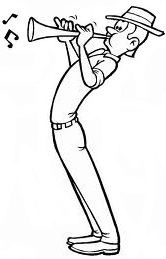 A
Jennersdorf Tradition: Bob Strauch shared a short Burgenland ORF article about
a tradition in Jennersdorf. Specifically, for the past 100 years, the city band goes from
house to house in the days between Christmas and New Year's playing for the residents. While
they do not attempt to play for all 2000 Jennersdorf households each year, they do try to
reach everyone at least once every three years. Residents reciprocate for the good music and
good wishes with drinks, pastries and small donation to the band association. See
http://burgenland.orf.at/news/stories/2565223/ for the full German-language article and a
short video. A
Jennersdorf Tradition: Bob Strauch shared a short Burgenland ORF article about
a tradition in Jennersdorf. Specifically, for the past 100 years, the city band goes from
house to house in the days between Christmas and New Year's playing for the residents. While
they do not attempt to play for all 2000 Jennersdorf households each year, they do try to
reach everyone at least once every three years. Residents reciprocate for the good music and
good wishes with drinks, pastries and small donation to the band association. See
http://burgenland.orf.at/news/stories/2565223/ for the full German-language article and a
short video. New Years Wishes: Hannes Graf wrote with New Year's wishes, saying also that he and wife Elsie had gone to the Leopoldsberg (north of Vienna along the Danube) about 2 hours before midnight to see the fireworks together... with about 2 million people!  Latin
Resources: Margaret Kaiser wrote to pass along word that John McCoy had posted
webpage
www.rootsweb.com/~chevaud/latin.htm containing some Latin resources for genealogists,
including examples of Latin from different periods and sources (such as church records) and
with different styles of script that you might encounter in manuscripts that have genealogical
content. He notes that Latin has a long tradition of abbreviations that need to be seen to be
correctly interpreted. His page is a good start! (We are adding this link to our BB URL/Links
page.) Latin
Resources: Margaret Kaiser wrote to pass along word that John McCoy had posted
webpage
www.rootsweb.com/~chevaud/latin.htm containing some Latin resources for genealogists,
including examples of Latin from different periods and sources (such as church records) and
with different styles of script that you might encounter in manuscripts that have genealogical
content. He notes that Latin has a long tradition of abbreviations that need to be seen to be
correctly interpreted. His page is a good start! (We are adding this link to our BB URL/Links
page.)PA Record Chase: A year ago, in the January 31, 2012, edition of the BB Newsletter (No. 217), I mentioned in my "President's Corner" section that I had received a short note from Joe Jarfas (of Equinunk, PA) about "...an important development in the PA 'record chase'." Specifically, there was "a grass-roots effort to have Pennsylvania's older birth and death certificates be made available online." The ultimate goal, was to get the certificates scanned, indexed and placed online. At minimum, the group wanted a searchable index placed online. In response, I sent a letter to the PA Governor's office on behalf of the BB that endorsed these goals. Early this past September, I received a note that progress was being made but, due to my move in late August (to PA, as it turned out), the message was buried and I failed to mention it. This month, while organizing and/or deleting old messages, it has once more come to my attention, so I'll share that progress report. Jan Meisels Allen, Vice President, IAJGS (International Association of Jewish Genealogical Societies) writes: One of the success stories for records access last year was Pennsylvania— Pennsylvania Vital Records Bill SB-361 was signed into law as Act 110 of 2011 on December 15th, 2011 and went into effect on Feb 13th, 2012. It makes death certificates over 50 years old and birth certificates over 105 years old open records. Another provision was to transfer the certificates to the Pennsylvania State Archives once they become open records—all deaths certificates from 1906 to 1961 and birth certificates from 1906. As each year goes by another year's worth of birth and death certificates would become open records. To achieve the goal of the records available online, the State Archives recently signed a contract with Ancestry.com to have the records scanned and made available online. The process started on August 27 with the earliest records—1906 records starting to be transported to the Ancestry.com site in Maryland. After each year is complete it is expected the records will be placed online and data extracted. The whole process is expected to take 18 months and as each batch of records is scanned that particular patch will not be available to patrons. The contract gives exclusive online access to Ancestry for three years after which the database will be moved to the Pennsylvania State Archives website where it will be free to all. However, the contract does require that Pennsylvania residents have free access to this particular database on Ancestry. Many libraries and research centers everywhere provide free access to Ancestry. The data to be extracted includes: dates of birth and death, parents' names including the mother's maiden name and hopefully the place of birth. At this time I do not know when the records will be available on Ancestry. The information is from PaHR the People for Pennsylvania Historical Records Access, the group that was behind the legislation and led the "fight" for access to records for several years. For more information go to: http://home.ptd.net/~timarg/PaHR-Access-FAQ.htm and scroll down to "When Will the Records Be Available Online". Deportation of Germans Memorial Day: Margaret Kaiser shared a note about an event that occurred this past month in Hungary. The note was based on a statement issued by the Hungarian Ministry of Public Administration and Justice:
I find this new memorial event (or even more so, this series of new memorial events)
interesting in light of the claims of some that the current Hungarian government is Christian-
and Magyar-centric and quick to blame others for what happened in Hungary in the past. Perhaps
the italicized quote above—the "message" for the series of events—echoes that claim... it is
not that 'we shall never do this again', rather, it is 'we will not tolerate
it happening to us again'. While that is one possible interpretation, I'll also
note that one of the event's speakers is the President of the Pest County German
Self-Government, so clearly there is currently a vigorous German community in Hungary
(Pest is the county that surrounds Budapest) and may be the 'us' of the quote.
If you haven't heard them in person at least once already, catching one of these shows may
be a worthwhile investment of your time and hard-earned money. For more information about a
specific concert, website
http://www.wienersaengerknaben.at/en/dates/usa provides the exact location, time and the
link to the venue's ticketing website. I wrote back to Frank to say that, given we have permission from the Donau
Club, I’d be pleased to present their recipes, especially those that have a Burgenland slant.
Given I was not raised on ethnic Burgenland food, I asked Frank to pick some appropriate
recipes. He has now started sending me selections, saying "...[wife] Elsie and I are
culling through ...to identify recipes that are typically associated with Burgenland. There
are a number of such recipes." |
||||||||||||||||||||||||||||||||||||||||||||||||||||||||||||||||||||||||||||||||||||||||||||||||||||||||||||||||||||
2) MARRIAGE DISPENSATIONS While helping a BB member read a note on a Burgenland Catholic marriage record, I became curious about marriage dispensations... My questions were: 1) When was dispensation needed? 2) Who could give a dispensation? 3) What were the causes/grounds justifying a dispensation? The dispensation note in the above-mentioned marriage record indicated that there was a "second degree" blood relationship that was dismissed, thus giving permission for the marriage to proceed. It should be noted that dispensations mostly affected Catholic marriages. I say mostly because the Swedish Lutherans also required dispensation for some marriages and all mixed marriages (i.e., Catholic/Protestant, of any Protestant persuasion) required dispensation for the Catholic involved in the marriage. You might ask why there existed this disparity in Catholic and Protestant practice concerning dispensation. The answer directly involves the key issue that caused the Catholic/Protestant split. That is, the Catholic Church required a Diocesan-based fee (i.e., an "indulgence") to be paid to process and obtain a dispensation. Since indulgences were the key cause of the Lutheran split, it was quite unlikely that the Lutherans and other Protestants would put themselves in a position to also require a processing payment. Thus, generally speaking, Protestants placed fewer restrictions on marriages but were far stricter about enforcing those limited restrictions. I need to provide a little more background before addressing my three questions. The Catholic Church (and most Protestant Churches) recognized what it called "Divine" or "natural" law as being distinct from "Ecclesiastical" or "Canon" law. God's "Divine/natural" law could not be dismissed; however, man's "Ecclesiastical/Canon" law was subject to being dismissed when doing so was beneficial in a particular situation for the individuals involved or for the religious community as a whole. [Note: I'll use the capitalized single word, Church, to refer to the Catholic Church in the following discussion, as it is the only denomination where most of this applies.] As for marriage, the Church recognized four classes of impediments to marriage that might be subject to dispensation. These involved certain degrees of relationship between bride and groom: 1) through blood, called consanguinity; 2) through marriage, called affinity; 3) by being god-parents in Baptism or Confirmation, called spiritual affinity; and 4) created through adoption, called legal affinity. Every direct blood-line relationship (consanguinity) between potential spouses was considered by the Church to be against Divine law, where a direct relationship was one where one spouse was sired by the other... i.e., father with daughter, granddaughter, etc; and mother with son, grandson, etc. By definition, these type of relationships could not receive a marriage dispensation. Collateral blood relationships (consanguinity), however, depended on degree. The nearest (first degree) collateral blood relationship is brother–sister. Second degree relationships included first cousins (children of parents who are siblings) and uncle–niece and aunt–nephew relationships. The simplest third degree collateral consanguinity was between second cousins. Higher degrees follow similarly. This leads to the answer to my first question, 1) When was dispensation needed? Early Church Canon law (506 AD) banned collateral marriages closer than fourth degree consanguinity. Prior to that, second degree and higher marriages were allowed. The ban was increased to seventh degree from the 11th to 13th Centuries but was then returned to fourth degree when it became apparent that most people did not know about relations that distant in degree and, even if known, the rule forbade too many potential marriages given the smallness of most towns. While the Church has never granted a dispensation for first degree consanguinity (i.e., brother–sister), second through fourth degrees were subject to dispensation starting with the 506 AD ban. It was only in 1917 that the Church allowed third degree consanguinity without dispensation; however second degree still requires dispensation. The Protestant denominations also outlawed direct blood-line consanguinity but generally permitted first cousin marriages and above (second degree and higher collateral consanguinity), citing the Mosaic regulations specified in Leviticus 18, 12–18. However, Leviticus does not explicitly mention all relationships that would be banned by this rule, so this caused some serious disagreement in the early Protestant churches, which led, in part, to the Swedish Lutheran Church establishing more strict rules (but allowing dispensation, for a rather high fee, until 1844). Both Catholic and Protestant churches now recognize local civil laws, and neither church will perform a marriage in lower degrees than that local civil law allows; however, both refuse to solemnize marriages that do not meet their own standards (even if civil law allows such). The Eastern Orthodox Church still permits only fourth and higher degree consanguinity relationships (without dispensation). Affinity, of all types, could also require dispensation by the Church. Impediment by simple affinity (i.e., by marriage), was, for example, when someone's spouse died and the widow / widower wanted to marry the brother / sister of the deceased spouse (a first degree affinity; higher degrees follow in parallel to consanguinity). Although affinity up to the fourth degree was on the books as an impediment, Catholic Burgenland records are full of such marriages. In fact, it is my impression (not backed by a serious count) that this was the most common recourse for a widow or widower with young children... a brother/sister in the deceased spouse's immediate family stepped forward to provide the replacement father or mother. Perhaps these marriages are all marked with a dispensation... but I've never noticed that. Likewise, spiritual affinity and legal affinity required dispensation. One was not allowed to marry one's God-child or an adopted child, much like marrying your own blood-line child was banned. However, I've never noted such a marriage of this type in the Church records so do not know how it was handled in practice. 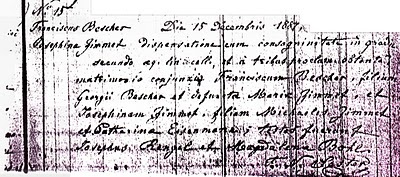 This
leaves dispensation for consanguinity, specifically collateral consanguinity of the second
through fourth degrees, for further discussion. It is the type of impediment I've seen most
often addressed in the Church records and is the type for which my original questions were
intended. This
leaves dispensation for consanguinity, specifically collateral consanguinity of the second
through fourth degrees, for further discussion. It is the type of impediment I've seen most
often addressed in the Church records and is the type for which my original questions were
intended. The second question, 2) Who could give a dispensation? is easy to answer... The Church allows the right of dispensation to be delegated down to local bishops, who handle most dispensations, though the actual right is held by the pope and has been administered from that level. However, regardless of who gives the actual dispensation, the reasons for requesting a dispensation must be placed in writing, must meet Canon law, and must (typically) be presented by the local priest for consideration. As such, it may be possible to obtain that documentation as to why a dispensation was requested in a particular case and why it was approved or rejected. [Note: I have never attempted to obtain a copy of such a document; if any of you readers have done so, I'd be interested in hearing about how you obtained a copy and what details were in the document.] I'd guess that such records, if they still exist, are in the local Diocesan archives. I'll now address my last question, 3) What were the causes/grounds justifying a dispensation? The basis for the sixteen canonical causes for matrimonial dispensation I'll list below come from an Instruction issued on 9 May, 1877 by the Church's "Sacred Congregation of the Propagation of the Faith," as this is from a time period often of interest to BB members. There was also a 1901 "Formulary of the Dataria" that gave twenty-eight causes, though the extra causes appear to be nothing more than sub-causes listed among the Instruction's 16 causes. While I have not investigated deeply, the causes listed in 1877 appear to be fully consistent with prior practice. What is interesting about the text of the Instruction
is that some explanation is given as to why a particular cause is considered sufficient (or
sufficient when considered with other causes). My take is that the Church was quite pragmatic
and expedient in its thinking (at least from its point of view). That is, it believed there
were social and religious needs that were more important than whether a single closely-related
couple married. It was considered better to maintain the social fabric and religious
solidarity than worry about following the letter of its man-made Canonical Law (called "common
law" below). |
||||||||||||||||||||||||||||||||||||||||||||||||||||||||||||||||||||||||||||||||||||||||||||||||||||||||||||||||||||
3) A BURGENLÄNDER GOES HOME (by Ann Leitgeb Green, Candler, NC) 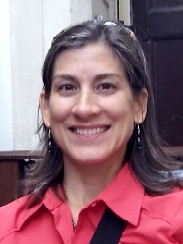 My
father is Austrian. My mother, now deceased, was Italian and Spanish. So naturally, my first
trip to Europe was to these three countries. My
father is Austrian. My mother, now deceased, was Italian and Spanish. So naturally, my first
trip to Europe was to these three countries.I became interested in genealogy a year or two ago. At that time, I received copies of family records from my first cousin (once removed), Erika, who lived in Güssing. Communication with her was the push I needed to make travel plans for the biggest thing I’ve ever done. After months of planning, tons of patience on my husband’s part, and many missed mountain bike rides, we were off. Below are excerpts from my travel blog. September 25, 2012 I was wondering when it would hit me that we were going to Europe. At the Asheville airport? On the plane? The layover in Amsterdam? The first thing I noticed in the Amsterdam airport was the CHOCOLATE — to the ATM, quick, there's chocolate to be had! And... my first passport stamp. :) The thought of 'when will it hit me' wasn't in my mind when it happened... on the flight to Vienna. Watching the beautiful landscape coming into Vienna, I thought it looked like a quilt. There were large patches of farmland that made a visually textured pattern with different colors and shades of green and beige. Dotted among these patches were clusters of trees and villages—white buildings with reddish roofs. It all looked so peaceful and simple. The flight attendant said the weather was sunny and warm with a slight breeze coming from the south. I don't know about Austria, but in the US, the breeze hardly ever comes from the south. I had the slightly dorky but sweet thought that my ancestors from Burgenland were saying hello to me, welcoming me to the country of my father's parents. All this hit me in an instant and I couldn't stop the rush of emotion and tears. This is really happening! 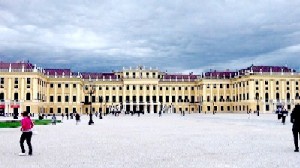 Everyone who knows me knows I'm quite emotional and
easily moved. Walking around Vienna is an overdose of visual beauty—the buildings are
beautiful; architectural excellence—one can appreciate the workmanship and commitment it took Everyone who knows me knows I'm quite emotional and
easily moved. Walking around Vienna is an overdose of visual beauty—the buildings are
beautiful; architectural excellence—one can appreciate the workmanship and commitment it took
 to
erect these buildings hundreds of years ago; and nostalgia—I imagine my relatives walking the
same streets and seeing the same buildings. I'm sure they did… my grandfather and at least one
of his brothers were born right here in Vienna. Uncle Franz lived here with Aunt Rosa and,
from pictures I've seen, certainly looked happy. to
erect these buildings hundreds of years ago; and nostalgia—I imagine my relatives walking the
same streets and seeing the same buildings. I'm sure they did… my grandfather and at least one
of his brothers were born right here in Vienna. Uncle Franz lived here with Aunt Rosa and,
from pictures I've seen, certainly looked happy. After checking in to our room, we walked around town a bit and found a nice Italian place that could make us a vegan meal. We had a very good pasta dish and a bottle of Spanish wine. I thought, how fitting... we're in Austria... drinking Spanish wine... in an Italian restaurant... my entire ancestral heritage right here at this table! The first thing that really amazed us was St. Stephen's Cathedral. Talk about an overdose... this place is massive, looming over the street with its huge tower and intricate design. It's being restored (as are many, many buildings in town). A watchman used to keep an eye over the city from the tower; it takes 343 steps to get to the top. September 26, 2012 We were on our way to the tourist information office when we stumbled past a church on Michaelerplatz. We went inside and this was another 'awe' moment for us both, for different reasons. I had to fight back tears. I was awed by the devotion to God that was so palpable. Whether you’re religious or not, you feel something special. Those Roman Catholics sure can build churches! We were both awed by the work it took to build it and the age of it. It's hard to wrap my American mind around buildings being hundreds of years old, let alone still being in use. 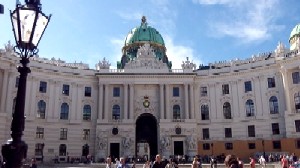 Then
came the Hofburg—winter home of the Habsburgs, who ruled for six hundred years. We took
so much time going through the Silver Collection (which I thought might be a bit boring but
was very interesting) and the Sisi Museum (she was quite a woman—her compassion for Hungary
helped save the country and she and her husband, Franz Josef, became King and Queen of the
Austro-Hungarian Empire), that we had to rush though the royal apartments (very similar to the
Biltmore Estate). We had no idea it would take so long... but we could have stayed all day.
Our feet were killing us and we were very hungry. We had wanted to see a couple other sights
but now didn't have the time or energy. Then
came the Hofburg—winter home of the Habsburgs, who ruled for six hundred years. We took
so much time going through the Silver Collection (which I thought might be a bit boring but
was very interesting) and the Sisi Museum (she was quite a woman—her compassion for Hungary
helped save the country and she and her husband, Franz Josef, became King and Queen of the
Austro-Hungarian Empire), that we had to rush though the royal apartments (very similar to the
Biltmore Estate). We had no idea it would take so long... but we could have stayed all day.
Our feet were killing us and we were very hungry. We had wanted to see a couple other sights
but now didn't have the time or energy.As we worked our way back through town, we kept seeing bakeries. The bread looked 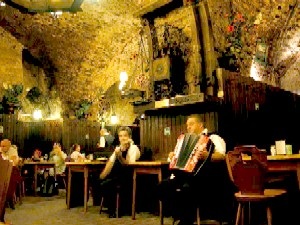 SO
good. Finally, John suggested we go in and see what they had for us. The girl we spoke to said
we found the best bakery in Vienna. She had just come back from North Carolina and
loved Asheville! What are the odds? We bought a baguette of hearty, crusty bread. Then we
headed in search of the Zwölf Apostelkeller. This is a restaurant and wine bar that
serves local wine. It's built on a former monastery. What an authentic experience! We walked
in and were directed down and around to the cellar, led there by music. We saw two men playing
Austrian music on the violin and accordion. They greeted us with a hearty 'Abend!' We
sat and enjoyed an incredibly delicious bottle of gold-medal-winning wine. We couldn't wait to
taste the bread, so we didn't. It was so good we thought putting anything on it would take
away from it. SO
good. Finally, John suggested we go in and see what they had for us. The girl we spoke to said
we found the best bakery in Vienna. She had just come back from North Carolina and
loved Asheville! What are the odds? We bought a baguette of hearty, crusty bread. Then we
headed in search of the Zwölf Apostelkeller. This is a restaurant and wine bar that
serves local wine. It's built on a former monastery. What an authentic experience! We walked
in and were directed down and around to the cellar, led there by music. We saw two men playing
Austrian music on the violin and accordion. They greeted us with a hearty 'Abend!' We
sat and enjoyed an incredibly delicious bottle of gold-medal-winning wine. We couldn't wait to
taste the bread, so we didn't. It was so good we thought putting anything on it would take
away from it.September 28, 2012 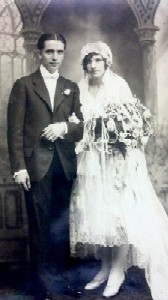 We
picked up the rental car—a Mini Cooper, what fun—and drove south on the A2 toward Burgenland.
We went to Kroatisch Ehrensdorf, one of the tiny villages of my father's ancestors. I wanted
to take pictures of all the headstones in the cemetery for fellow Burgenländer, Steve Geosits,
who I met through the Burgenland Bunch newsletter. Thanks to him, I have one branch of my
family tree going back seven generations—all from eastern Austria / western Hungary. He also
gave me house number information... I had three houses to look for that my family members
lived in so long ago. I was able to find only one. That's ok—house #9 is where my
great-granduncle was born! We
picked up the rental car—a Mini Cooper, what fun—and drove south on the A2 toward Burgenland.
We went to Kroatisch Ehrensdorf, one of the tiny villages of my father's ancestors. I wanted
to take pictures of all the headstones in the cemetery for fellow Burgenländer, Steve Geosits,
who I met through the Burgenland Bunch newsletter. Thanks to him, I have one branch of my
family tree going back seven generations—all from eastern Austria / western Hungary. He also
gave me house number information... I had three houses to look for that my family members
lived in so long ago. I was able to find only one. That's ok—house #9 is where my
great-granduncle was born!
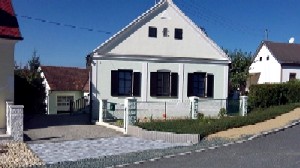 This
was extra special because this uncle is the person who sponsored my grandfather’s travel from
Vienna. All the villages down here are so tiny, crisp and clean and look so peaceful. As I was
walking up and down the street looking for one of the other houses, John said to me from the
car, 'turn around'. I did and there was an old woman peeping out her door. I waved,
said ‘Guten Tag!’ and headed toward her. I was able to practice some German, as she
didn't speak English. She recognized the last names and, I think, told me some went to America
and some to another village. It was a very touching experience and I hugged her as I thanked
her for her help and said good-bye. This
was extra special because this uncle is the person who sponsored my grandfather’s travel from
Vienna. All the villages down here are so tiny, crisp and clean and look so peaceful. As I was
walking up and down the street looking for one of the other houses, John said to me from the
car, 'turn around'. I did and there was an old woman peeping out her door. I waved,
said ‘Guten Tag!’ and headed toward her. I was able to practice some German, as she
didn't speak English. She recognized the last names and, I think, told me some went to America
and some to another village. It was a very touching experience and I hugged her as I thanked
her for her help and said good-bye.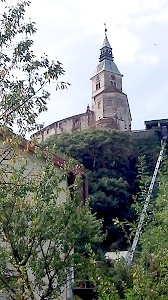 Next
we headed to Güssing, where my cousin Erika lived. The first thing we saw heading into Güssing
was the Burg—the remains of a huge castle looming over the district. On our walk up to it, we
stopped to watch a pair of peregrine falcons tending to their young, perched on the side of
one of the castle walls on a tiny, narrow ledge. The young falcons were very vocal and the
parents just floated Next
we headed to Güssing, where my cousin Erika lived. The first thing we saw heading into Güssing
was the Burg—the remains of a huge castle looming over the district. On our walk up to it, we
stopped to watch a pair of peregrine falcons tending to their young, perched on the side of
one of the castle walls on a tiny, narrow ledge. The young falcons were very vocal and the
parents just floated
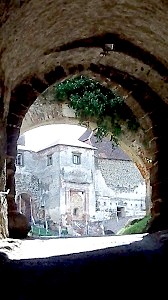 in
the air above the wall—a beautiful sight. How amazing the walk through the castle was. Built
in the 1100s! Really?! Stop and think about that for a minute. It was more impressive than the
Hofburg and Schönbrunn in a lot of ways. John was much more impressed and
enjoyed touring this castle more than the Habsburg residences. My husband is a retired builder
and always points out craftsmanship that I would surely miss. He appreciates a structure’s
longevity and integrity more than its opulence. in
the air above the wall—a beautiful sight. How amazing the walk through the castle was. Built
in the 1100s! Really?! Stop and think about that for a minute. It was more impressive than the
Hofburg and Schönbrunn in a lot of ways. John was much more impressed and
enjoyed touring this castle more than the Habsburg residences. My husband is a retired builder
and always points out craftsmanship that I would surely miss. He appreciates a structure’s
longevity and integrity more than its opulence.There was a nice wine bar/restaurant we noticed earlier (of course), so we sat outside and ordered yet another good bottle of Austrian wine. This was the best bottle we've had so far. The owner asked us what we're doing in little ol' Güssing, so I told her about my cousin Erika... that we were in touch until months ago; that she knew we were coming; and that we knew she was sick and we were concerned since we hadn't heard from her in so long. Trixie, the cafe owner, said she knows Erika (of course she does, Güssing only has 4000 people!). She made a call and gave us information about where Erika was. She was very ill and at a hospital north of there. She had to have some amputations (right leg; left toes) due to her poor health. She has had a heart transplant and two kidney transplants. I'm sad that we didn't get to see her but glad she knew we were coming. From our outdoor table at this restaurant, we could see Erika’s apartment building. 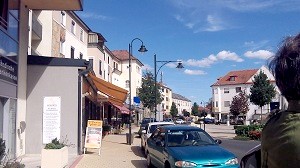 We
left Güssing and headed back north to Vienna on the A2. Or so we thought. How we ended up
going the wrong way, I'll never know. Oh wait—maybe it's because the signs don't say A2 NORDEN
or SÜDEN. After about 30 minutes, I figured it out and we turned around. We
left Güssing and headed back north to Vienna on the A2. Or so we thought. How we ended up
going the wrong way, I'll never know. Oh wait—maybe it's because the signs don't say A2 NORDEN
or SÜDEN. After about 30 minutes, I figured it out and we turned around.We managed to get off at the right place, fill up the car despite the clerk not speaking English (unofficial sign language can communicate a lot), and find the correct tram to the train station. Forgive us Vienna, but we owe you 2.20 Euro. We tried to overpay, but the machine only takes exact change. We stored our bags at the train station and walked a few blocks to a good vegan restaurant where we met my cousin, Lucy, Erika’s daughter. She brought her beautiful German Shepherd dog, Rapture, a sweet and well-behaved boy. I like how laid-back the attitude is here about dogs in restaurants. We had a nice visit, said good-bye, and took our train to Salzburg. Final Thoughts 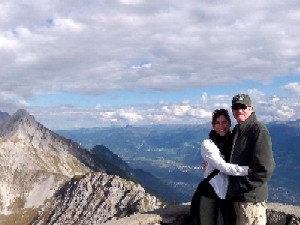 The
rest of our trip was full of more amazing sights and touching moments… and very uncomfortable
travel experiences in Italy. Galicia and Santiago de Compostela, Spain, were worth the flight
from Rome to Vigo. The
rest of our trip was full of more amazing sights and touching moments… and very uncomfortable
travel experiences in Italy. Galicia and Santiago de Compostela, Spain, were worth the flight
from Rome to Vigo.After four weeks in Europe, we came back to North Carolina with an expanded sense of home, a desire to go back, and more patience on the road (we made the mistake of driving in Palermo). I have all of my grandfather’s immigration forms. One has his Vienna address just before immigrating to the USA in 1922. I have seen this form many times but never noticed the address before. I wish I had seen that before we left, as now I know we walked within several blocks of his building on our way to the Schönbrunn. Another reason to return to Austria… Full travel blog at: http://travelpod.com/members/anngreen |
||||||||||||||||||||||||||||||||||||||||||||||||||||||||||||||||||||||||||||||||||||||||||||||||||||||||||||||||||||
4) NEUSTIFT BEI GÜSSING This article was motivated by a note from Frank Nikischer, Jr... Frank writes (in part): Dear Tom, thank you so much for your newsletters. It's always interesting to learn about my ancestry. My grandparents and many of their friends emigrated to the United States from Neustift bei Güssing after WW1. Although I don't have a great deal of time to research my ancestry, I do try to learn as much as I can and your newsletters are a great source of information. I would be very interested in seeing any articles from past newsletters or perhaps something in an upcoming newsletter concerning the history of Neustift bei Güssing and how to access genealogy information. Thanks so much. The truth is, I tend to avoid writing about the smaller towns. This is not because they are less interesting or important, rather, it is because it is usually much harder to find information and/or pictures about them. Nonetheless, I decided to take up Frank's challenge and write an article (especially since he gave me some outs by allowing for prior articles and instruction on how to obtain Neustift genealogical information... these are easy!). So here goes, Frank!  Neustift bei Güssing: (Hungarian: Újtelep), part of the municipality of Kukmirn, is a scattered, hilly farming and residential community in the Güssing district with slightly over 500 residents that is situated some 7 kilometers (4.3 miles) southwest of Güssing. Historically, it is an agricultural community of some 1,150 hectares (2,840 acres / 4.44 sq miles), but farming is in decline and, like much of southern and middle Burgenland, the inhabitants tend to work outside the community, mostly in the Vienna area. While no other recognized villages are Ortsteiles of Neustift, there are the named residential areas of Weberberg, Mürbischgraben and Narringerberg in the village Hotter, as well as a large wooded region to the northwest known as the Fidischwald. Its average elevation, 265 m (870 feet), is not close to either the lowest point in Burgenland, 113.5 m (372 ft) in Apetlon, nor the highest point in Burgenland, 884 m (2900 ft) at Geschriebenstein (on the border near Köszeg). The population is 97% German-speaking, with but a few Hungarian or other nationalities. Surrounding Gemeinden are Güssing (to the northeast), Inzenhof (east), Heiligenkreuz im Lafnitztal (south), Eltendorf (west) and Gerersdorf-Sulz (north). 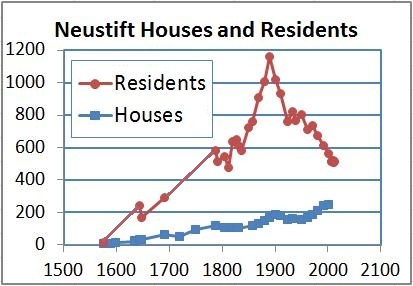 Like
much of rural southern Burgenland, the population of Neustift has declined over the last
century, after reaching a peak of nearly 1,200 in 1890. Consistent with the trend in developed
countries, the number of inhabitants per household has fallen from a high of around 7
in 1890 to today's 2.3. Despite the population decline, the number of houses in the
Gemeinde has grown fairly steadily, with the minor dips in house counts coinciding only
with times of war. Like
much of rural southern Burgenland, the population of Neustift has declined over the last
century, after reaching a peak of nearly 1,200 in 1890. Consistent with the trend in developed
countries, the number of inhabitants per household has fallen from a high of around 7
in 1890 to today's 2.3. Despite the population decline, the number of houses in the
Gemeinde has grown fairly steadily, with the minor dips in house counts coinciding only
with times of war.Ellis Island shows 90 emigrants from Újtelep (Neustift's Hungarian name) during the time Ellis was open. There are also 322 from "Neustift" (spelled exactly that way), but given that there are three Neustifts in Burgenland and another four elsewhere in Austria, it is hard to tell accurately how many of these emigrants were from Neustift bei Güssing. Nonetheless,159 of the surnames closely match those listed under Újtelep, and another 10 or so match from among close spelling variations of Neustift, so we can plausibly assume about 260 residents of Neustift/Újtelep chose to emigrate to America between 1897 and 1924. These emigrants, plus the deaths due to WW-I (Neustift was hard hit), account for much, but not all, of the decrease in the early 1900s. The rest of the decrease, we might assume, were people who attempted to improve their economic situation by going to bigger cities in Austria and to other countries in the wider world. Unlike many Burgenland communities, Neustift contains a mix of Catholics, who historically attended church in Güssing, and Lutherans, who attended in Kukmirn and later Eltendorf. 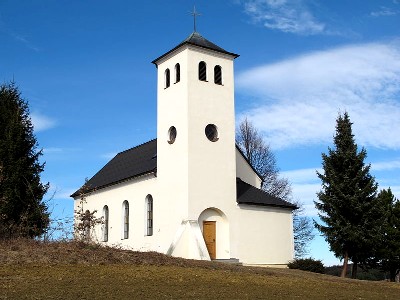 Locally,
the churches were the providers of the earlier schools. The Catholic elementary school was
established around 1700, with a major reconstruction in 1879. By 1824, an Evangelical
elementary school had started but a full schoolhouse was not built until 1860; it was rebuilt
in 1889. Locally,
the churches were the providers of the earlier schools. The Catholic elementary school was
established around 1700, with a major reconstruction in 1879. By 1824, an Evangelical
elementary school had started but a full schoolhouse was not built until 1860; it was rebuilt
in 1889. In more recent times, the Burgenland state government built a public school, opening it in 1958; it is still the largest building in Neustift. A few years before, the Catholics had built a branch church in Neustift, St. Anthony of Padua, which was consecrated in 1955. With the opening of the public school in 1958, 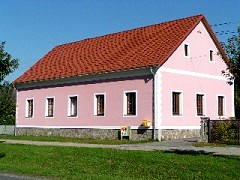 the
Evangelicals quickly 'countered,' by consecrating the former Evangelical school as a
Protestant prayer hall (Gebetshaus). The Catholic elementary school is now a music
school. the
Evangelicals quickly 'countered,' by consecrating the former Evangelical school as a
Protestant prayer hall (Gebetshaus). The Catholic elementary school is now a music
school.As for other civic facilities, a post office was opened in 1889 and the volunteer fire department was established in 1890. More recently, electricity was introduced in 1949, first in the village then into the outlying areas during the following decade. Prior to the construction in 1956 of the Güssinger Straße (Highway 57; see road on left in the first picture in this article), which connects Güssing to Heiligenkreuz by way of Neustift, the village was quite isolated from the rest of Burgenland, being dependent on only cart trails and foot paths to reach markets in other towns. Expansion of and improvements to supply roads (such as the smaller road to the right of the highway in the above-mentioned picture) began in the 1960s, increasing connectivity and allowing Neustift to become an active member in the greater Burgenland community. In 1964, a ski lift was built in the Gemeinde (the first such ski lift in all of Burgenland) but it proved unsuccessful and eventually closed. In the early 1970s, the community joined the Lower Lafnitztal Water Board, thus securing a stable water supply. In 1971, Neustift attempted to legally merge with the villages of Inzenhof, Kleinmürbisch, Großmürbisch and Tschanigraben, creating a local "greater community," an initiative that resulted immediately in legal challenges. It would not be until 1991 that the Burgenland Constitutional Court finally ruled that such an amalgamation did not conform to the Structural Improvement Act, leading to the dissolution of the combined community that year. From 1977-1979, a mortuary and chapel were installed at the cemetery, then a bell was added in 1982 for tolling at burial services. In the early 1980s, construction of a sanitary sewage system was undertaken. In 1990, a pre-school/nursery was begun in the elementary school buildings. There is also a Liquor Museum that celebrates and presents the fruit-based spirits and wines of southern Burgenland. Neustift is proud of its active club life and considers it an important part of the community. The volunteer fire department, being both a service and social organization, 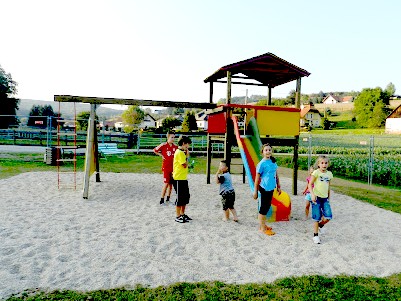 celebrates
its 130+ years of existence. The local chapter of the ÖKB (Österreichische
Kameradschaftsbund / Austrian Association of Comrades) was founded in the 1950s to
preserve the memory of soldiers killed or missing in wartime and to maintain military graves.
The football club (Sportverein ASKÖ Kickers; a soccer team in American parlance) was
formed in 1986 and actively competes against other village clubs. The Tourism and
Beautification Association designs and maintains the local public spaces and spearheaded
installation of a children's garden and playground. In addition, there is a Dart Club, Bowling
Club, Singing Circle, Pensioners' Association, Christmas Savings Club, and an Association for
the Protection of Traditions. celebrates
its 130+ years of existence. The local chapter of the ÖKB (Österreichische
Kameradschaftsbund / Austrian Association of Comrades) was founded in the 1950s to
preserve the memory of soldiers killed or missing in wartime and to maintain military graves.
The football club (Sportverein ASKÖ Kickers; a soccer team in American parlance) was
formed in 1986 and actively competes against other village clubs. The Tourism and
Beautification Association designs and maintains the local public spaces and spearheaded
installation of a children's garden and playground. In addition, there is a Dart Club, Bowling
Club, Singing Circle, Pensioners' Association, Christmas Savings Club, and an Association for
the Protection of Traditions.Early History of the Village: Like elsewhere in Burgenland, Neustift still contains the traces of earlier civilizations. There are two cairns, Stone Age burial barrows, in the Fidischwald; these indicate very early settlement. Neustift also existed at the first foundation of the Dominium Güssinger and the building of the Güssing castle in 1157. Because of Neustift's proximity to the castle, attacks on and sieges of the castle created much havoc and suffering in Neustift. Neustift's history is one of repeated devastation beginning in 1273, when Bohemian warriors under king Premysl Otakar II took the castle; again, in 1289, when Berthold of Emmersberg, the commander for Duke Albrecht of Austria, conquered it; and yet again in 1327, as King Charles Robert of Anjou, forced the castle to surrender. Nonetheless, the Counts of Güssing were powerful enough to hold the castle until the line died out in 1387. Ownership then reverted to the Hungarian King, Stephen, who gave it to the Peterfi family. They lost it to Nicholas Ujlaky, prince of the Siebenburgen, who was forced to pay tribute in 1495. When the Ujlaky line became extinct in 1524, it was then acquired by the Batthyánys, who still own it today. The Batthyánys also acquired dominion over Neustift, establishing four or five farms therein. It is during the thirteen- and fourteen-hundreds that an earlier Hungarian name for Neustift appears. A 1301 map lists it as Gödör (pit). In 1428, it is listed in a property transfer as Gederfew, though this is likely a phonetic spelling of the Hungarian name, now Gödörfö (main pit). These names suggest that some form of mining was active in the area. The first use of the German name, Neustift, would not appear in writing until the year 1604, where 'Neustift' was identified in a charter as belonged to the castle. From that point, the name appeared in parish registers with variations such as Noistift, Nuistift, and Neistift. The 1720 Urbarium would list it as Naistiffth. It is speculated that the German name appeared after the town was repopulated by Germans following the Turk invasions of 1532. Genealogical Data & Newsletter Articles: Frank Nikischer, in the note that motivated this article, also said he would be interested in prior BB articles and instruction on how to obtain Neustift genealogical information. I'll make a few comments about prior newsletter articles then discuss sources for Neustift genealogical data. Realistically, since our newsletters are history and genealogical based, these are really the same thing, so my second section will really be about "external sources for Neustift genealogical data." It appears that the word Neustift appears in 69 prior BB newsletters. I know this by using the Search Box on the BB Homepage, putting Neustift in the "Enter Key Words here" box and selecting "Search BB Newsletters only" in the last box. None of these newsletters contain a comprehensive look at Neustift bei Güssing, and some likely refer to a different Neustift, but those that do apply provide tidbits, be they merely family names associated with the village or something else. It does not take long to work through these pages to see what is said since the Search will return a clickable list taking you to the appropriate newsletter. Once you finish looking at one page, you can go back to the Search Results and select the next page. However, since the Search does not take you directly to the entry within the newsletter, I suggest you also use the "find" tool in your browser on each page. For example, in Internet Explorer, "Find on this page..." is on the Edit pulldown menu or can be selected via CTRL-F (hold down the control key and press F). Google Chrome also uses CTRL-F to pull up its find tool. (As BB Editor, I often use this exact process when writing articles to see what we've said in the past... and I did so for this article!) Possibly a better source of BB-written material about Neustift is its Village History file found via our Villages pages (if the village name has a hyperlink, it takes you to the history file). A direct link to that page for Neustift is: http://www.the-burgenland-bunch.org/V_Histories/NeustiftbeiGussing.htm. (While we do not have a village history pages for every village, and some we do have are quite thin, it is a source you should try to look at for your village.) Our BB Houselist pages, http://www.the-burgenland-bunch.org/HouseList/HouseLists2.htm, give a snapshot in time (usually around 1856-8) of names of property owners. The Neustift-specific page is: http://www.the-burgenland-bunch.org/HouseList/GS/Neustift.htm. In addition, the BH&R (Burgenländers Honored and Remembered) sister-site (http://www.the-burgenland-bunch.org/BH&R/home.htm) contains useful data. While this data is not sorted by village or origin (rather, it is by place of burial), a village-sorted index can be found online at the end of the book we created in 2012 about BH&R. See the back pages of http://www.the-burgenland-bunch.org/Newsletter/222/1_BHR_book.pdf for page numbers involving Neustift. As for external genealogical data, the foremost resource is the church and civil records available through the LDS and their Family History Centers. As noted above, Neustift Catholics attended in Güssing, so their records would be there. Lutherans attended in Kukmirn (and later Eltendorf, though we do not have a date for that change). I would review the Kukmirn records before looking at Eltendorf if your ancestors were Lutheran. Civil records (post-1895) were held in Güssing. Keep in mind that the available records are indexed under their Hungarian names, not the German names. For Neustift records, Németujvár=Güssing, Kukmér=Kukmirn and Ókörtvélyes or Körtvélyes=Eltendorf. The table below was extracted from our BB LDS Films pages and gives the location, type of records, time era, and film number for the available records.
Pre-1895 records (i.e., church records) are available on microfilm which can be rented
through a Family History Center. Some of these records have been indexed, by place of
recording (not place of birth), and this index can be searched online for free at
https://www.familysearch.org/. However, the actual
record image (available only on microfilm) will have more information than the limited data
available in the index. Nonetheless, the index is a worthwhile initial resource. |
||||||||||||||||||||||||||||||||||||||||||||||||||||||||||||||||||||||||||||||||||||||||||||||||||||||||||||||||||||
5) ETHNIC COLORING & MIGRATION TO BURGENLAND I recently had an email exchange with BB member Connie Bernardy, of Fridley, MN. She has ancestors from Apetlon in the Neusiedl district and wondered about the physical ethnic characteristics, especially Mongolian or Turkish, that appear in her line. Later, the question came up of when her Germanic ancestors arrived in Burgenland. Both topics are of interest to me, as I also have seen these physical characteristics in my line and have wondered about when my Germanic Wallern ancestors (a village adjacent to Apetlon) arrived. I share selected parts of our conversation below as I believe they have general interest for some of our readers. Connie Bernardy writes: Tom, Thanks for the newsletters. If I can be of help let me know. I am part of the Midwest club. My Weinzetl ancestors are from Apetlon. We can go back to the 1700s. They settled in South Bend, Iowa and then southwestern MN. Until I got involved the Midwest group about three years ago, they didn't know about the Burgenländer settlers in this part of Iowa. I am very interested in learning as much as I can about my Burgenländer ancestry so I appreciate your newsletters. I am especially interested in knowing where I got my dark eyes and my dad got his dark completion and hair. What I know about Burgenländers now, I think we might be of Turkish decent but have not been able to identify it. We actually have Mongolian characteristics as well. In museums, the Mongolians look like my father and especially my grandmother. We have hooded eyes and that fold on the inside of our eyes. Ethnically, my father could pass for Jewish, Mexican, Turkish or America Indian. Any thoughts or information you have that might be helpful please do share with me? Like I said earlier, if I can ever be of help please let me know. I replied: Hi Connie, A pleasure to hear from you! As to ethnic coloring, Burgenland, as a border area, has always been a mixing pot... nowadays it is primarily German / Hungarian / Croatian but the past is replete with many ethnic groups and places of origin. The Hungarians are believed to be related to the Mongols, so seeing some Mongolian characteristics among some of us is not surprising (the Hungarians are also related to the Finns, a group which also not infrequently shows slanted/hooded eyes and darker coloring, even from parents with none of those characteristics). Likewise, the Turks ruled much of Western Hungary for the 150 years prior to 1683... and the Turkish armies came through the Apetlon area a number of times, sowing more than just apple seeds along the way. Thus there is plenty of mixed-Turkish blood to be found in Burgenland even today. In addition, there was a longstanding Jewish minority in Burgenland, which tended to be concentrated in the northern part where Apetlon is. I can't say I'd expect a Mexican connection but since American Indians are believed to be related to the Mongols, that similarity makes some sense too. 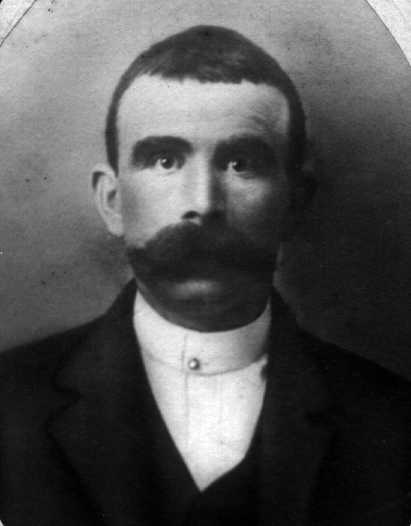 Like
you, I have a great-grandfather (born up the road from Apetlon at Halbturn) that I believe
could pass for Mongol, Jew or Turk; what do you think: Like
you, I have a great-grandfather (born up the road from Apetlon at Halbturn) that I believe
could pass for Mongol, Jew or Turk; what do you think:I also have/had hooded eyes (though I had surgery done to remove the worst of it when it became a vision problem) but I show none of the other characteristics. One thing you could consider doing to sort out some of your ethnic heritage is to participate in the Burgenland DNA study being run by Frank Paukowits. The BB is not a sponsor, though we give Frank free publicity about it. This is a male-line study, so you would need to have your father or a brother provide the DNA sample… as such, it would only represent that single ascending male line (but there might be a surprise in it!). The last time we mentioned the study in a Newsletter was in http://www.the-burgenland-bunch.org/Newsletter/Newsletter218.htm#08 (Feb 2012). A contact email and some info about the study is presented there. I’ll be glad to discuss this further if you wish. Connie replies: Thanks for the info. I did get the national geographic DNA data info from another male Weinzetl who is likely a very distant cousin. We met through the Burgenländer emails, I believe. I did learn that my Burgenländer ancestors were ethnically German. They emigrated from Germany to Burgenländer but I don't know when. I learned from our Midwest Burgenländer group that they think they likely emigrated from the Baden-Wurttemberg, or maybe even Bavaria, based on similar last names in these regions. In your opinion would you characterize this part of my tree as Austrian, German or Burgenländer. This one always stumps me. We thought we were Austrian but the more I learn the more I uncover about the their actually ethnicity. I replied: You raise an interesting question, Connie. The 1856 house list for Apetlon and the 1828 census for Pamhagen shows the Weinzetl name but the 1715 census (for any village in the area) does not. The earliest date I find where the Weinzetl name appears is in Pamhagen and Wallern in 1785 as part of a marriage. This likely places the emigration of the Weinzetls into the Apetlon area in this 1715-1785 window. This could be part of the post-Turkish resettlement of Hungary, with your people stopping in westernmost Hungary rather than continuing deeper into Hungary. It has been argued that “It is generally thought that the German population of the ‘Seewinkel’ (Pamhagen and neighboring villages) descends from immigrants from southern Germany (Bodensee area), who arrived sometime after the second Turkish siege of Vienna (1683), during which most of the Seewinkel villages had been destroyed.” However, I have done a comparison of surnames for Wallern from before and after 1683 and find that more than half the Wallern surnames present in the 1715 census were also present before 1683. Most certainly there was some fill-in with new names in the area (and your people seem to be among them) but, for at least Wallern, there was not a wholesale replacement. I would assume neighboring villages (like Apetlon) fared similarly, though some less protected village populations were largely erased and replaced. Nonetheless, the absence of the name in 1715 suggests they were not early replacements. Does this match well with the family history as you know it? In my opinion, you are ethnic Germans AND American and Burgenländer AND Austrian AND German (if you can prove this last part to your satisfaction). Saying you are “Austrian” only defines your line as a resident (now or in the past) of that place… but Austrians were ethnically Italian, Croat, Hungarian, German, Slovenian, Jewish, and many other… but I don’t think there was historically an ethnic “Austrian” …the core group of people considered themselves German. It would only be after the formation of the German Empire in 1871 (without Austria) that an ethnic “Austrian” identity came into being. In your case, you can prove you are “Austrian” and “Burgenländer” and have reasonable cause to believe you might be “German,” however, Germany was not a known entity in the 1700’s… it was merely a loose confederation of independent states… so why claim it? Well, for the same reason I claim Burgenland, I guess. It is now the name of the place some of my ancestors once lived (even though they emigrated away before it obtained that name… which is also true of some of my “German” ancestors), so I am a “Burgenländer” (and a German and a Luxembourger). There is no easy answer, so I say feel free to call yourself whatever feels best; that’s what I do. Did that confuse things more? Connie replies: Thanks! This is super helpful. I am going to look at how far back we go tonight. I am interested in seeing the dates to see how they coincide with the dates you mentioned. On my dad's side, his father, a Luxembourger (Lanners(ch)), married his mother, a Burgenländer (Weinzetl). His father's parents were from Luxembourg (Lanners) and Bohemia (Stephenova). His mom's parents were of German/Luxembourg descent, Hippert, and Burgenland descent, Weinzetl. On my mom's side, a Dane (Molgaard) married a German (Meyer). I will let you know what I find out for dates. Connie follows up on her reply: I go back to four people of the same generation in Apetlon. Do you know the name of the man who does all the birth, death and marriage record translations in Apetlon and the surrounding area? He gave these names and dates to me. I also got a bunch from James Weinzetl from Tomah, Wisc. Michael Weinzetl, b abt 1790, married to Katherina Wulkersdorfer, b abt 1795. Their child was Jacob Weinzetl, 1817-1869. Born around the same time in Apetlon was Gregor Thell, married to Margaret Munzenreider. Their child was Katherina Thell who married the Jacob listed above. I don’t have dates for them. Doe this give you any theories or thoughts? I replied: Hi Connie, In digging more into Weinzetl, I found a 1716 marriage in Wallern that involved a 19 year-old Weinzetl girl… that caused me to dig more. The 1720 census for Pamhagen lists a Joannes Vanczetl. I’d bet that was really a Weinzetl. The “cz” is likely the Hungarian phonetic form for a German “z” and W and V were quite interchangeable in early German. The “a” for “ei” is less likely but these old census records tended to greatly mangle names. Given the “Joannes” spelling for Johann (Janos in Hungarian), this strongly suggests the census recorder preferred Latin over either German or Hungarian (other given names also reflect this Latin bias). If so, the mangling of surnames also makes sense. I went back and looked for something similar in the 1715 census for area villages but struck out. So now I’d narrow down the emigration window to late 1715 to early 1716, though it could be the earliest Weinzetl family was there earlier and simply wasn’t an official landholder until after 1715. Nonetheless, all this is consistent with your 1790 Michael Weinzetl. It looks like the family may have landed in Pamhagen (the bigger town) then expanded over to nearby Apetlon. In looking at my family tree, I see I have an Elisabeth Weinzetl from Pamhagen, born ~1800; also a Gregor Thell from Apetlon, born ~1840 (as well as other, more recent Thell’s); no Wulkersdorfer or Munzenreider’s. Connie replies: I just saw this email after reading a different one you sent while I was sleeping. This is incredible. Thank you. I am going to look at out possible connections. It's amazing you were able to pin point the emigration date like you did. I wonder if there was a wave at that time or mine were late arrivers? I replied: Oy! I just looked at the actual images of the 1720 and 1715 census records and see that the transcriber also added to the issues. There is a Joannes Vanczetl listed in 1720 in Pamhagen, but right before him is a Georgius Vanczetl (one wouldn’t know that given the way it was transcribed). Also, 1715 for Pamhagen shows a Georgius Vanczedl (almost certainly the same guy as 1720). Thus it appears your people arrived before 1715! The 1675 Urbarium for Pamhagen does not list any Weinzetl-like names, so the post-Turk (post-1683) emigration still seems likely. If nothing else, the window now appears to be 1675-1715, with after 1683 being highly likely. I have no idea for pursuing this any closer… other than if you have some idea about the city they may have emigrated from… I’d see if a Georg Weinzetl was in those records and then disappeared. Connie replies: This is very helpful as Jim Weinzetl from Tomah, Wisconsin, who tracks all the Weinzetls in America, gave me his line which I believe ties to George Weinzetl. I will have to ask him what he knows about the translation Vanczetl as it relates to his line. I was told Weinzetl meant keeper of the books at a winery. Do you know what Van would mean? If I recall correctly Jim's line may go back to Pamhagen. You have been so helpful. Thank you for you research. The fact we likely came from the Bodensee area is very interesting. This is the most detailed info about our origination before Burgenland that I have received.. We have a friend who is 100 Bavarian and he looks like he could be my Dad's relative. I'll need to research why they left the area and also chose Burgenland. I am also I interested in knowing when they came to Burgenland was it considered Austria or Hungary. Would they see themselves as more Hungarian or Austrian? My parents did visit relatives there about twenty years ago. You taught me about a new area, Seewinkel. I am interested in knowing what that tells me about my people. I do know we are related to the Weinhandls if that brings meaning to anything. Connie replies again to my earlier message: On my tree we have another line of Thells from Apetlon. It seems, possibly, cousins married. Johann Thell was married to Rosalia Jandl, 1818-1841. I show one child born to them, Susanna Thell, in 1851 who died in 1886. She married Michael Weinzetl, who was born 1843-?. I don't know if Johann Thell and Rosalia Jandl had additional kids together. Curious if these two are the parents of your relative Gregor Thell born in abt 1840 in Apetlon? Johann then married Anna Schwarz and they had Michael Thell in 1843, which is not one of my direct decedents. It would be cool of our family trees connect then. There is a chance, being he is a Thell in Apetlon and my Thell relatives in Apetlon were having babies at that time. We could then figure out our cousin connection, which is always a treat for me. I replied: Don’t think of Vanczetl/Vanczedl as a ‘translation’ of Weinzetl, Connie. Rather, it is a written phonetic interpretation of the spoken name Weinzetl. Letters have different sounds in different languages so writers interpreted those sounds in the way they would be written in their preferred language. Thus the spoken German “z” sounds like ‘cz’ to a Hungarian and a German-spoken ‘W’ would be heard by a Latin speaker as ‘V’. Of course, the “zetl” piece is likely a Hungarian-inspired contraction of the German ‘zettel’. Van has no meaning in German; in Hungarian it has a number of meanings: is/exists; has/possesses/owns; or, at least. None of those relate to Wein. Of course, Wein is German for wine (and has no meaning in Hungarian); Bor is the Hungarian word for wine. Zettel is German for piece of paper, note(-paper) or label (and has no meaning in Hungarian). While one could put Wein and zettel together as wine-note(paper) or wine-label and potentially get ‘bookkeeper in a vineyard’ from that, it is a stretch. One of our more knowledgeable German staffers once interpreted the name as ‘day laborer in a vineyard,’ though what his logic was in getting to that interpretation he did not say. There is a fair amount of discussion in the BB newsletters about the various German migrations into Burgenland, however, hard facts are difficult to come by. Without a doubt, the Austro-Hungarian leadership actively recruited settlers to repopulate Hungary after the Turks were driven out. There were 3 major waves of government-organized and supported resettlement, of which, I discussed in newsletter 208, article 8 (http://www.the-burgenland-bunch.org/Newsletter/Newsletter208.htm#08), however, all of these took place after 1715 and targeted southeast and central Hungary. But the nobility and Catholic Church recruited earlier, so there was active movement, mostly into western Hungary, before 1715. Burgenland was part of the Austro-Hungarian Empire throughout this period but was (legally) in the Hungarian sphere of influence. However, Burgenland (i.e., “German West Hungary," as it was once known) eventually became part of Austria because it was German-dominated and thought itself to be more Austrian than Hungarian. I think most people leaned toward their ethnic group… Germans to Austria, Hungarians to Hungary, etc. The Seewinkel (i.e., Lake Corner) is the area tucked in next to the eastern shore of the Neusiedler See. Further east was the Heideboden area. The Weinhandl name is also from the area. Its meaning is wine handler (wine trader), though that does not mean that is what they did in Burgenland. A last note: My Halbauer surname first appears in Wallern's then-Lutheran church records in 1654-1659 where Matthis and Ursula Halbauer are listed as birth parents of Elisabeth (1654), Jacob (1656) and Eva (1659), as well as godparents to other children. The surname is in Wallern's 1675 Urbarium (as Halbbauer), however, it is not apparent in a 1589 recording of names in Wallern. The surname also appears in later villages records as the Magistrate (Jacob Halbauer) in the 1710-1715 period. Like Connie's Weinzetl surname, there are issues in the 1715 and 1720 Urbariums. At first glance, it is strangely missing from the 1715 Urbarium (though it may be recorded incorrectly as Jacobus Halbrecht), as one would expect the 1715 Magistrate to be a taxpayer. Likewise, there is no exact Halbauer in the 1720 Urbarium ...but there are a Jacobus Holbsaur, Christianus Holpaur, Matthias Holczpaur and Sebastianus Hapaur, and since Jacob was known to marry twice and there are no other likely progenitor names in earlier records, these are likely Jacob and (some of) his sons. Hopefully, when earlier church records become available, I'll be able to prove this and possibly connect my line. My exact line is documented back to a birth in Wallern in 1736 to a Johann Halbauer, born ~1691, though the available records do not state Johann's birth location nor his parents names. So, while I believe my exact Halbauer line likely arrived in Wallern between 1589 and 1654, I can only prove they were present in 1736 and later. Where they came from prior to 1654 (or even 1736) is unknown... but it is a Germanic name. |
||||||||||||||||||||||||||||||||||||||||||||||||||||||||||||||||||||||||||||||||||||||||||||||||||||||||||||||||||||
6) HISTORICAL BB NEWSLETTER ARTICLES Editor: This is part of our series designed to recycle interesting articles from the BB Newsletters of 10 years ago. The article that I chosen this month comes to us through the auspices of staff member Fritz Königshofer and was first published in December 2002 (NL #113). Fritz explains the origins of the text in his preface below. THE BURGENLAND BUNCH NEWS No. 113 December 31, 2002 HISTORY OF POPPENDORF (by Fritz Königshofer) Preface My great-grandfather Adolf Königshofer was born into a family of teachers in Neudau, Styria, right at the historical border (Lafnitz river) between Austria and Hungary. He studied at the teacher preparation schools in Graz and Oberschützen. After finishing his education in 1882, he applied for a position in Olbendorf, then in Hungary, which meant that he also needed to apply for home rights in Olbendorf and Hungarian citizenship. He worked in Olbendorf till 1886, became schoolmaster in Gamischdorf, where he worked till 1898, when he received his final appointment at the Roman Catholic elementary school in Poppendorf, succeeding the retired Emil Langasch, great-grandfather of Gerry Berghold. Poor health forced Adolf to retire in 1914. He died in Poppendorf in 1921, just before Burgenland came into existence as part of Austria. Adolf was a correspondent for Der Volksfreund, a German weekly published in Szombathely. Some of his contributions to the newspaper, especially his stories on emigration and on major events in Poppendorf, have already been published in earlier editions of the BB newsletter. In the unfortunately few personal effects we were able to save within our family, there is a manuscript of a "History of Poppendorf" which he must have worked on in the second decade of the 20th century. A first excerpt from this manuscript was published in issue 39A of the BB newsletter of July 15, 1998, an issue that was dedicated to the village of Poppendorf. It is important for readers to recognize that the following manuscript clearly was at an early stage (with the entire two sections about the time between 1872 and 1915/20 still missing), and that Adolf was a village teacher, not a historical scholar. Phrases in square brackets (including question marks) denote marginal notes by Adolf which he apparently planned to work on, or correct, in the next drafts, while normal parentheses are either as used by Adolf in the manuscript, or provided by my minimal interpretations (as should always be clear from the context). The following represents the entire saved manuscript and additional, clearly related sheets. History of Poppendorf (by Adolf Königshofer) (Transcribed and translated by his great-grandson Fritz Königshofer, version of November 28, 2002) Introduction 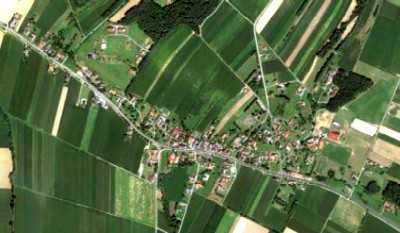 Poppendorf
lies along the river Lafnitz at the left side [Ed: north-northeast side] of the Lafnitz
valley, near the foot of a slowly rising chain of hills. The main street through the village
leads toward Styria, passing over one stone bridge and two bridges of brick masonry. To the
left and right of the road lie the 74 houses covered with straw or with brick tiles [and
having vine railings]. Some of the houses on the left side, in the direction of the flow of
the river [Ed: east-southeast], already are located on the slope of the hills, and thus
are more distant from the road than the others. To the right of the road, some village oaks
[?] approach very closely, as do the fertile, not "comassierten" (i.e., re-organized) Hofäcker
(i.e., the usually small farmland around the houses in the village itself) which, like the
grass and vegetable gardens, are partly separated from the main road by live beech fences. Poppendorf
lies along the river Lafnitz at the left side [Ed: north-northeast side] of the Lafnitz
valley, near the foot of a slowly rising chain of hills. The main street through the village
leads toward Styria, passing over one stone bridge and two bridges of brick masonry. To the
left and right of the road lie the 74 houses covered with straw or with brick tiles [and
having vine railings]. Some of the houses on the left side, in the direction of the flow of
the river [Ed: east-southeast], already are located on the slope of the hills, and thus
are more distant from the road than the others. To the right of the road, some village oaks
[?] approach very closely, as do the fertile, not "comassierten" (i.e., re-organized) Hofäcker
(i.e., the usually small farmland around the houses in the village itself) which, like the
grass and vegetable gardens, are partly separated from the main road by live beech fences.
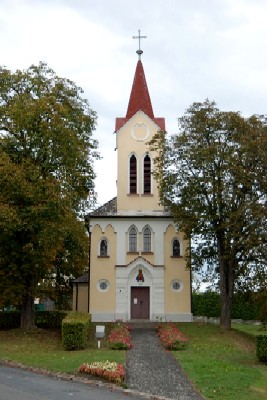 On
a small elevation at the lower half of the village lies the widely visible village chapel
built in Gothic style [grocery Hacker, or Hartler?]. On the main road near the chapel, one
finds the large inn ("Einkehrwirtshaus") of the current inn-keeper Julius Medl. In the middle
of the village stands the old chapel together with old linden trees, at which the road
branches off which leads to Poppendorfbergen which is about 20 minutes away [old cemetery??].
Over the street to the right there are the "Millenium" (thousand year old??) linden trees
[Berghold inn, Jani (?) store]. At the upper half of the village on the left lies the Catholic
schoolhouse with its front yard, and 100 steps further down on the right hand side, the
Lutheran schoolhouse with its orchard and vegetable garden. In the schoolhouse, there is also
the post office [just opposite the civil office where Franz Berghold runs his store]. The
teacher also serves as postmaster. Above the Catholic schoolhouse flows a little brook which
comes from the hills; during longer lasting spells of dry weather, this little brook dries
out. On the other hand, when it rains heavily, the brook carries such huge amounts of water
that they cannot all flow under the bridge and thus have to take their way over the road,
flooding vegetable beds and adjoining lawns and thus creating damage. Above the just mentioned
bridge, there stands an old cross surrounded by acacia and linden trees. On
a small elevation at the lower half of the village lies the widely visible village chapel
built in Gothic style [grocery Hacker, or Hartler?]. On the main road near the chapel, one
finds the large inn ("Einkehrwirtshaus") of the current inn-keeper Julius Medl. In the middle
of the village stands the old chapel together with old linden trees, at which the road
branches off which leads to Poppendorfbergen which is about 20 minutes away [old cemetery??].
Over the street to the right there are the "Millenium" (thousand year old??) linden trees
[Berghold inn, Jani (?) store]. At the upper half of the village on the left lies the Catholic
schoolhouse with its front yard, and 100 steps further down on the right hand side, the
Lutheran schoolhouse with its orchard and vegetable garden. In the schoolhouse, there is also
the post office [just opposite the civil office where Franz Berghold runs his store]. The
teacher also serves as postmaster. Above the Catholic schoolhouse flows a little brook which
comes from the hills; during longer lasting spells of dry weather, this little brook dries
out. On the other hand, when it rains heavily, the brook carries such huge amounts of water
that they cannot all flow under the bridge and thus have to take their way over the road,
flooding vegetable beds and adjoining lawns and thus creating damage. Above the just mentioned
bridge, there stands an old cross surrounded by acacia and linden trees.At many of the houses of Poppendorf one can find fruit trees, so that from far away it looks as if the entire village is immersed in a large orchard grove. Just outside the village are four houses at the lower end of the village, while there is one house at the upper end, towards Eltendorf [houses of craftsmen]. The village proper ("Hotter") is poor in flowers. Most frequently one finds the Pechnelke (catch-fly, viscaria vulgaris), Knabenkraut (orchis), Augentrost (eyebright, euphrasia officinalis), Vergissmeinnicht (forget-me-not, myosotis), Gänseblümchen (daisy), Huflattich (tussilago farfara), Löwenzahn (dandelion), Glockenblume (hare-bell, campanula), Tausendguldenkraut (centaury, erythraea), and in the autumn on the meadows the Herbstzeitlose (autumn crocus, colchicum autumnale) [poisonous snakes?]. The meadows on the left bank of the Lafnitz have sweet grass, while the ones on the right bank have grass which is only usable as horse feed. Poppendorf is also not rich in timber. The most frequent tree is the forest pine ("Kiefer"). The people incorrectly call it "Tanne" (fir). One can also find spruce trees, but only in small numbers; also beech and oak trees. Vine growing is still practiced here and there in the hills [Poppendorfbergen]. The Lafnitz river lies about seven minutes away from the village. The Lafnitz [or Lan (??) as the people call it] has roughly the same width throughout. Its greatest width, about 8 meters (26.5 feet), is at the so-called Heubrücke (hay bridge). There are several spots where the depth of the river reaches 10-12 meters (33 to 40 feet), for instance near the field belonging to Jost. The river bed is uneven, often like a trough, and is either muddy or solid. Due to the effects of washing out, the banks of the river are often vertical, and contain lots of underbrush and old trees and tree trunks that have fallen into the water. About 20 footsteps downriver from the Heubrücke, one can still see a large, very old oak trunk which extends into about a third of the river's width. This trunk must have lain there for ages as even the oldest inhabitants of the village, as far as they remember it, have found the trunk at this place. This oak tree perhaps stood near the river bank, and fell into the Lafnitz as the result of a heavy storm or the erosion of the river bank. It can hardly have come there from flooding. There are no branches anymore on this trunk. One can only see the trunk of about 80 centimeters (32 inches) diameter of which half can be seen above the water during dry periods with low water levels. 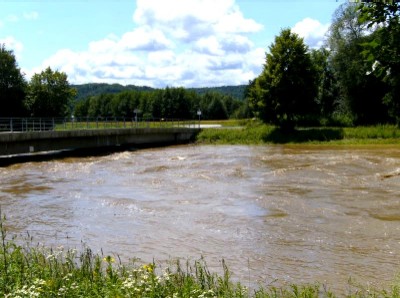 When
it rains extensively, or after torrential downpours, the Lafnitz often rises above its banks
and floods the nearby fields and meadows. The river leaves its bed at its left bank about 100
footsteps upriver from the Heubrücke, and also downriver from the same bridge, at the meadows
belonging to Spitzer, and over its right bank just downriver from the Eltendorf flour mill. As
for fish, the most frequently found is the Zinkel (perhaps meaning the Zingel, belonging to
the perch family), a bottom feeder and predator, reaching a weight of up to half a kilogram [a
bit more than a pound]. This fish has a very tasty meat. Apart from carps, pikes, Wels
[Scheiden?] (catfish), which can all reach respectable sizes, the latter 60 to 80 kilograms
(135 to 180 pounds), one can find many other kinds such as Weissfisch (literal translation:
white fish, a generic term for small fish often belonging to the carp family), Barsch (perch),
Barben (a rather large species belonging to the carp family), and Platten (??) as the people
call them. Catching the fish is very difficult. First of all, the fish find enough food and
therefore do not bite into bait, while, secondly, a fishing line or net easily gets caught in
the thicket that lies at the bottom of the river. The unevenness of the bottom also prevents
results with casting-nets. When the water is high, one may have some success. People also go
fishing during the time of spawning. Everybody is allowed to fish by fishing net; it's free.
One is supposed to have a fishing card (a permit), but nobody cares about it. There are also
fish otters in the Lafnitz. During wintertime, they have often been seen sitting on the ice
[they damage the fish stock]. The people don't go after them. The owner of the Poppendorf
hunting lease, Josef Medl, sometimes chases them. When
it rains extensively, or after torrential downpours, the Lafnitz often rises above its banks
and floods the nearby fields and meadows. The river leaves its bed at its left bank about 100
footsteps upriver from the Heubrücke, and also downriver from the same bridge, at the meadows
belonging to Spitzer, and over its right bank just downriver from the Eltendorf flour mill. As
for fish, the most frequently found is the Zinkel (perhaps meaning the Zingel, belonging to
the perch family), a bottom feeder and predator, reaching a weight of up to half a kilogram [a
bit more than a pound]. This fish has a very tasty meat. Apart from carps, pikes, Wels
[Scheiden?] (catfish), which can all reach respectable sizes, the latter 60 to 80 kilograms
(135 to 180 pounds), one can find many other kinds such as Weissfisch (literal translation:
white fish, a generic term for small fish often belonging to the carp family), Barsch (perch),
Barben (a rather large species belonging to the carp family), and Platten (??) as the people
call them. Catching the fish is very difficult. First of all, the fish find enough food and
therefore do not bite into bait, while, secondly, a fishing line or net easily gets caught in
the thicket that lies at the bottom of the river. The unevenness of the bottom also prevents
results with casting-nets. When the water is high, one may have some success. People also go
fishing during the time of spawning. Everybody is allowed to fish by fishing net; it's free.
One is supposed to have a fishing card (a permit), but nobody cares about it. There are also
fish otters in the Lafnitz. During wintertime, they have often been seen sitting on the ice
[they damage the fish stock]. The people don't go after them. The owner of the Poppendorf
hunting lease, Josef Medl, sometimes chases them.There are no crayfish in the Lafnitz. Some years ago, they all perished from the Krebsenpest (crayfish plague?). Some people say that the dirty water that flows from the channels of the factories in Fürstenfeld into the Feistritz river was the reason for the extinction of the crayfish, but this explanation has to be doubted because, if dirty water were the reason, fish should also have perished. One can still find crayfish in the little tributary brooks of Eltendorf and Zahling. The disease affected mostly only the main waters. Ancient History No sources exist on the ancient history of the village. There are neither legends nor songs. There is just the conjecture that the first inhabitant had the last name Popp, and that this is how the name Poppendorf came into being, i.e., the village of the Popp(s). There is perhaps an alternative, as the legends of Gamischdorf say, in that there was a little hill there where the red Pfaffen (popas) lived, Greek-Catholic clergymen which are called Popen, and that a similar situation existed in Poppendorf and could be the source of the name of the village [which, however, is very doubtful]. As grave sites from Roman times have been found in nearby Königsdorf, this could also indicate a settlement in Roman times, because Poppendorf was on the same road which led from Sabaria (Szombathely) to today's Styria. However, there are no direct traces from Roman times in the entire village proper. Real History Of The Community The real history of Poppendorf can be divided into four parts: the history before 1848; the history from 1848 till the Comassierung (redistribution of land to eliminate the many small, separate parcels to allow more efficient farming) in 1872; then from 1872 till 1903 when Count Dénes Draschkovits of Güssing allowed the people of Poppendorf to purchase his Herrschaftsgrund (properties of his domain) there; and finally, from 1903 till the present. Before 1848 As was the case with all nearby communities, the inhabitants of Poppendorf were subjects of the Herrschaft (domain) Batthyány of Güssing, therefore they were bonded serfs. As such they had to provide the so-called robot for the land holder ("Grundherr"), and also had to give the so-called Zehent (tithe). The farmers had to provide 13 (??) days of robot per year, the Söllner (cottagers, i.e., house owners or renters with no or negligible farmland) 15 days. In total, there were 33 farmers and cottagers in Poppendorf (??, Adolf was not sure about the number). They were completely dependent on the whims of the land holder. Therefore, the inhabitants were a poor and abandoned people for whom, as long as they did their bonded duties, nobody cared a hoot. The village judge (mayor) was put in place by the landlord. He was the most powerful person in the village who could hang any recalcitrant person into the "Stock" (put into the stocks?, pillory?) or have him/her beaten up [the last of these victims was Michael Spitzer]. Both farmers as well as cottagers had own land, but mostly in the form of forests and the so-called "Au" (river meadows). The forests extended from outwards the village proper to the cemetery, while the river meadows reached from Heiligenkreuz to the road. From the current meadows of the notary and of the school endowment, and along the Lafnitz to the so-called Szellischen (?) meadows and from there extending to the road, everything was river meadow. There were 1,000 years old oak and alder trees on these river meadows [These were the property of the land holder. People were allowed to collect Klaubholz (fallen timber). Nevertheless, much timber was just taken without asking and without qualms.]. With the domain administration's permission, people could let their livestock graze on the river meadows from spring to October, such as horses, cattle and pigs under the supervision of herdsmen. A typical farmer had one to two pieces of cattle. The ploughs were made of wood, and farmers helped each other out. They could not afford to have more cattle because the river meadows comprised only the Lang (?) and the bridge meadows, the grass was too acidy, and there was too little of it for the entire village. Behind the yard of Simitz, where there was also the place for cutting clay into bricks (the brickyard), there stood the village's hay barn. This is where the hay was collected from the village meadows. If anybody needed this hay in the winter, he was able to purchase it from there. Obviously, hay was often scarce. The poor cattle often had to live through the winter just from straw. This led to the situation that in the spring cows were sometimes too emaciated to stand up without the help of humans. This proves that livestock farming was at a very low level during these times [perhaps also due to low selling prices such as only 15-20 florins apiece; only farmers Baumann, Bosch, Drauch and Heber had enough cattle to be able to harness their own oxen pairs for ploughing. ??]. Holding horses was somewhat better understood, yet not too well either. It was not possible to earn much additional income from hauling, because before 1848 farmers simply had to spend too much time on performing their robot work for the domain. First came the domain, then the farmer's or cottager's own livelihood. The village judge did not care whether the inhabitants had time to sufficiently tend to their own fields, as his superiors were only interested in that the domain got its due. Pig farming was better developed. Often, a farmer had 6 to 8 pigs. They did not require much attention. In the spring, they were herded onto the river meadows, where they fed on acorns and grass till October. Back at home, some of them were slaughtered, the others were very cheaply sold [20-25 Kreutzer per pound, often without using a scale; apparently the innkeepers were sometimes the buyers]. There was no dearth of firewood and timber. Farmers and cottagers (Söllner) had their forests. Sometimes, one or the other went to the forest belonging to the domain to get whatever he/she needed. Of course, one had to avoid getting caught. The easy availability of wood is also the reason why houses and cellars were often built of timber, because this method incurred the least cost. Clothes were of linen [self-spun]. Trousers were wide (baggy). Shirts were held together by bands at the neck and the hands. The shirt fell down outside the trousers. Therefore, a colored apron was worn above it [women's clothes, fur trousers]. In winter times people wore a sheep-skin (as in Styria). This fur was tanned red or white, with flowers (??) on the back. 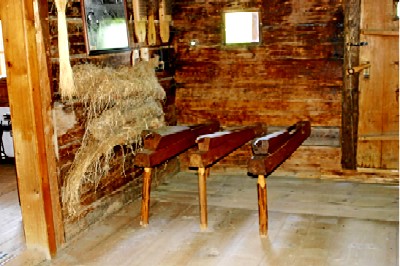 In
the Simitz yard stood the Brechelhütte (hut for breaking the flax). That's where people
brought their flax to for breaking. The people coming for the breaking were well received and
served with food. In
the Simitz yard stood the Brechelhütte (hut for breaking the flax). That's where people
brought their flax to for breaking. The people coming for the breaking were well received and
served with food.Otherwise, people mostly stayed at home. Rarely did anyone venture to other places. Rather, he or she stayed with the parents and shared the poverty with them. Therefore, there were many old bachelors and spinsters. When the parents died, one moved into the back room of the house, the other into the front room. It was not allowed to divide the land. The siblings peacefully lived with each other and ate from the same bowl. They also found themselves employment as farmhand or maid with a yearly remuneration [2 shirts, 2 trousers, apron, etc.]. At marriage, rarely was the groom younger than 30. For military service, the community had to make available either one or two men. It often happened that the military came to the village at night, got all young men out of their beds, and put them into the uniform on the spot. [At some times, the duty was for the village to provide half a man. In these cases two villages would jointly make one young man available for the draft.] If the young men had any advance warning of the arrival of the military, some would hide in the hay or the vineyard's cellar. The hapless drafted man would receive 40 to 50 florins from the village community. Then came the revolutionary year 1848 which for the Hungarian farmers brought the abolition of both bondage and tithe [Protestant chapel in 1846]. 1848 - 1872 The abolition of bondage meant, generally speaking, little immediate change for the community. The farmers now (from 1860 onwards) (still) had to deliver the "Zehnt" (tithe). This was the tenth part of their grain harvest. In the same vein, each vineyard owners had to hand over one "Mass" (old standard measure, perhaps one to two liters) of wine. The tithe was gathered together at the domain's manor farm ("Maierhof"), today's house no. 21, family Schlener. The last lessee of the manor farm, who lived at house no. 21, had the last name Knoblauch. Times, however, changed for the owners of horses. A tobacco factory was built in Fürstenfeld, and cotton mills came into operation in Burgau and Neudau. Since the railway did not exist yet, the tobacco and cotton had to be carted. Thus Poppendorf became part of the newly emerging hauling business. The carters carried tobacco from Molnári (probably the village of this name near Letenye in southern Zala county) to Fürstenfeld. They received 50 Kreutzer per "Zentner" (hundredweight, probably about 50 kilograms at the time). For four days of hauling, they could make 23 florins [Ed: = ~$24 in 1860 dollars = ~$670 in today's dollars], while for (the shorter distance from) Szalaegerszeg (sic) they could make 16 florins. It often happened that the tobacco carters removed some of the tobacco from the bales, then refilled the void with stones or bricks, or soaked the bale with water, so that proper weight was restored. The (Hungarian) tax inspectors were constantly busy in searching for (hidden?) tobacco. The people were hiding it in their hay barns, the fields or the forests. A lot of smuggling took place. Michael Spitzer, of house no. 17, and Andreas Schlener vulgo (original house name) Ruster Schlener (?) enticed the inn-keeper Johann Berghold to (illegally) haul tobacco. However, they were caught near Kanizsa (likely Nagy Kanizsa in south Zala county), and Berghold lost horse, tobacco and cart (presumably these were confiscated). Grain and limber were also hauled, even as far as Graz and Vienna. The remuneration for hauling goods from Fidisch (likely today's Rábafüzes) to Fürstenfeld was 2 Florins and 50 Kreutzer per day, and from Poppendorf to Szentgotthárd it was one Florin and 50 Kreutzer. By now, the farmers were on the road with their horses and carts most of the time, and did not come home during the week anymore. The money they earned, however, was easy to count. Most of it was spent en route at the inns. The entire burden of tending house and farm now rested on the shoulders of the wife. She lived at home with the children and brothers, and did as best as she could to manage. Meat cows and pigs were left grazing on the river meadows, and the horses were away hauling goods. Therefore, there was neither time nor means available to gather manure. As a consequence, the fertilization of the arable land became neglected, and thus quality and amount of people's nourishment also started to suffer.  People
mostly lived on bread, the so-called "Rubenfuszn" (?? beets?) [sugar?] and Heidensterz
(steamed and roasted buckwheat). People
mostly lived on bread, the so-called "Rubenfuszn" (?? beets?) [sugar?] and Heidensterz
(steamed and roasted buckwheat).
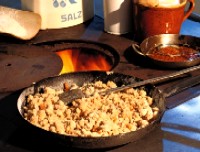 In
the stone mills of the flourmills, everything was milled "flach ohne Beutl" (flat without
bag?), into coarse meal. In the bread made from this very coarse flour, one could find
complete (grain) skins and bran. Despite of this, people were strong and sturdy, and reached a
high age. Their raw strength made them better resistant to illnesses. It gave them energy and
the means to reach a high age. The increasing variety of food prevents today's generation from
reaching the same full strength of the body. Another reason for the robustness of the previous
generations was the fact that the scarcity of owned land—the largest parcel was owned by
Spitzer of house no. 16 who harvested 40 X (measures?) of wheat in 1860—meant that the
workload for the individual was light. Young men and women, therefore, were able to take life
relatively easy ["Scheiben spielen," "Alte Burschen Strasse"], and none of them went far away.
Young men stayed at home all the time, or spent their time with entertainment/games. On the
place where Wallkovits has his house today, there was a skittles lane (rural bowling). Another
pastime was the game of "Zwak" (or Zwek?). In
the stone mills of the flourmills, everything was milled "flach ohne Beutl" (flat without
bag?), into coarse meal. In the bread made from this very coarse flour, one could find
complete (grain) skins and bran. Despite of this, people were strong and sturdy, and reached a
high age. Their raw strength made them better resistant to illnesses. It gave them energy and
the means to reach a high age. The increasing variety of food prevents today's generation from
reaching the same full strength of the body. Another reason for the robustness of the previous
generations was the fact that the scarcity of owned land—the largest parcel was owned by
Spitzer of house no. 16 who harvested 40 X (measures?) of wheat in 1860—meant that the
workload for the individual was light. Young men and women, therefore, were able to take life
relatively easy ["Scheiben spielen," "Alte Burschen Strasse"], and none of them went far away.
Young men stayed at home all the time, or spent their time with entertainment/games. On the
place where Wallkovits has his house today, there was a skittles lane (rural bowling). Another
pastime was the game of "Zwak" (or Zwek?).The daily wage for threshing [provided the person was sufficiently fast with the flail] for young men was 10-12 Kreutzer, "auf die Tür" (??, perhaps meaning "with delivery to the house) 25 Kreutzer. This was work done merrily and happily, whereby it was possible to express one's joy by singing, a fact which, on the other hand, some people in the village envied a bit.  [The
threshing was carried out with the "Drischel," and cleaning up was done with the shovel.
1860.] There was very little money around. Only one or two families in the village had a bit
of it, but even these only in modest measure. The poorer class had no money at all. If someone
had a few 100 Florins, he was considered rich [usury]. Such wealthier ones were Schlener at
house no. 50, Spitzer at no. 16, Schlener at no. 28, Gibiser at no. 29. (However, these names
were all struck through in the manuscript, and the following names written above them: Lorenz
Medl, Sulzer or Salzer.) The most festive days of the year, the so-called "meat days," were
the days during Fasching (carnival, Shrovetide, i.e., the time before Lent), and for the
poorer classes the days of vine harvest and pressing, and the days of grain and hay
harvesting. Winegrowing was popular among the inhabitants. In contrast, not much attention was
given to fruit growing which stagnated completely. Winegrowers harvested about 30 to 40 pails
of grapes. The best years for the wine harvest were 1868 and 1869. The grapes were noble
Hungarian varieties, mostly red ones. [The
threshing was carried out with the "Drischel," and cleaning up was done with the shovel.
1860.] There was very little money around. Only one or two families in the village had a bit
of it, but even these only in modest measure. The poorer class had no money at all. If someone
had a few 100 Florins, he was considered rich [usury]. Such wealthier ones were Schlener at
house no. 50, Spitzer at no. 16, Schlener at no. 28, Gibiser at no. 29. (However, these names
were all struck through in the manuscript, and the following names written above them: Lorenz
Medl, Sulzer or Salzer.) The most festive days of the year, the so-called "meat days," were
the days during Fasching (carnival, Shrovetide, i.e., the time before Lent), and for the
poorer classes the days of vine harvest and pressing, and the days of grain and hay
harvesting. Winegrowing was popular among the inhabitants. In contrast, not much attention was
given to fruit growing which stagnated completely. Winegrowers harvested about 30 to 40 pails
of grapes. The best years for the wine harvest were 1868 and 1869. The grapes were noble
Hungarian varieties, mostly red ones.Livestock-farming did not develop due to the scarcity of fodder. Prices also stayed depressed. For example, in the year 1860, Johann Berghold sold two horses in Graz for 64 Florins, and (with the proceeds) purchased two cows, one for 17 Florins, the other for 24. The price for a suckling calf ("Tuttelkalb") was 5-6 Florins, while a "Tuttelfadl" (suckling pig) cost 50 to 60 Kreutzer in 1860. Despite the rather low prices, very few in the village were able to afford buying enough meat for eating, as money was lacking everywhere. Those who, on top of this, still frequented the inns, lost house and farm ("Haus und Hof"). This fate happened to Andreas Gröller of house no. 51 who had a large farm but eventually died in the hospice for the poor of Güssing. [Gotzy and Zach also lost their properties the same way.] 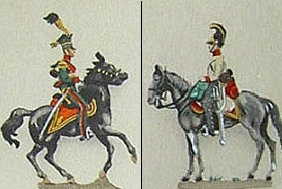 During
the winter months of the years 1860 to 1870, military were quartered in Poppendorf, namely,
Dragoons and Uhlans. Their riding school was at the brickyard near the arboretum [?], where
the community grazing meadows ("Hutweiden") are today. There were two kinds of inns
(Gasthäuser) in the village, firstly the inn owned by the domain which was leased by the land
holder (Herrschaft), and secondly the village inns which the village community had leased out,
and which had the right to pour (serve) wine from October to April. During
the winter months of the years 1860 to 1870, military were quartered in Poppendorf, namely,
Dragoons and Uhlans. Their riding school was at the brickyard near the arboretum [?], where
the community grazing meadows ("Hutweiden") are today. There were two kinds of inns
(Gasthäuser) in the village, firstly the inn owned by the domain which was leased by the land
holder (Herrschaft), and secondly the village inns which the village community had leased out,
and which had the right to pour (serve) wine from October to April.The night watch was carried out by a "Nachwächter" (night watchman) (a note suggests the possible name Hahn for this man) who was hired by the village and armed with a halberd ("Hellebarde," a kind of lance) which is still kept today in the vulgo Ruster house. The night watchman had the duty to be on the road from 9 PM to 4 AM, and cry out each full hour, by singing a short rhyme as follows. "Meine Herren und Frauen lasst euch sagen, der Hammer der hat xx geschlagen. Gebt Acht aufs Feuer und aufs Licht, damit euch der liebe Gott behüat. Hat xx geschlagen. Gelobt sei Jesus Christus." Translation: "Gentlemen and ladies let me tell you, the hammer of the clock has struck the hour of xx. Take good care of fire and light, so that the Lord may protect you. It is xx o'clock. Praised be Jesus Christ." The postal service first operated from Heiligenkreuz, but came to Eltendorf in the year 18xx (Adolf apparently did not know the exact year when he wrote the draft). The first postmaster was J. Nikitscher. Several times a week, a mail carrier went from Poppendorf to Eltendorf. The first mail carrier was the Herzlieb Nädl ("the old Herzlieb"), a 70-year old granny. The first notary was a Radó from Minihof. He was succeeded by Rudolf Ebenspanger in 1871. Previously, the writing duties were carried out by the teacher, and/or by the overseer ("Mahr") of the manor farm who was capable of reading and writing. In the year 1872 the land of the village was "comassiert" (see meaning above). This ends the contiguous text of Adolf's draft for the section covering 1848 to 1872, and thus the entire, clearly unfinished, manuscript. However, his papers contain an additional loose leaf as follows: With the abolition of the Leibeigenschaft (bondage), the tithe supposedly been abolished too. However, the aristocratic land holders (in this case, the counts Draskovits) nevertheless demanded the tithe. This enraged the farmers and they did not want to hand over the tithe. In Poppendorf, it was Schlener, house no. 47, who dissuaded the people from paying the tithe. He also managed to get the people of Zahling (village north of Eltendorf) on his side. The district judge ("Stuhlrichter," the highest civil servant of the district) arrived from Güssing with the intention to settle the conflict. In this case, however, the story goes that the people of Zahling locked the district judge into a pigsty and roughed him up with pumpkins. Now military was called in, and all the leaders and instigators received 25 (with the cane) on their posteriors. The old Angerhacker (family Hacker who perhaps lived at the village border—the "Anger"?) of house no. 39 also got his 25 laid on. As for Schlener, he had been hiding in the bed of Schabhüttl, house no. 60, but was betrayed. The Pandurs (a military formation of southeastern Hungary, originally set up for small-scale warfare during the Turkish Wars of the 17th and early 18th century, but later onwards evidently used to quell civil disturbances) surrounded the house, some of them entered it, and found Schlener in the bed under the straw. He was carried to the castle of Olmütz (now Olomouc in the Czech Republic) and nothing was ever heard from him again. Another loose leaf seems to note the first appearance in certain documents (perhaps the parish records) of family names of Poppendorf. Some of the names are underlined, i.e., probably the names that still existed in the village in the early 20th century. In the following transcript, these underlined names are enclosed by slashes: 1717: /Drauch/, /Koller/, /Gröller/, /Weinhofer/, /Gibiser/, /Medl Michael/, /Jany/, /Hans Homer/, /Josef Gerger/, /Berghold/, Klananzky, Weidinger Mathias, Scholl 1718: /Juschiz/, Popposchüz, Niklisch, Brunner (?), Hos Matthias, /Spitzer/, Dromor, Schram, Loibenpöck, /Zach/, Milner, Lacker 1720: /Bosch/, Lacky Andreas, Leiner, /Unger Andreas/, Eberhard Georg, Simonich, Plaukovisch Andreas, Schaukovitsch Michl, Nikischer Stöffel (Stefan), Laschiz Georg, Golles Michl, Praunstein, Matthias Jakis, Maas(t) Jakob, /Gamler Michel/ 1723: Jaundl, Chatharina (?), /Stelze(r)/, Schräml Michl, Latzer (?) Georg, Schmid Stöffl, /Pauman Josef/, Stary Andre, Georgy Rassner, /Zwikl Jacob/, Breiner Michl, /Scheme(l) Adam/, /Zieger Josef/, Hos Michl, Neubauer 1725: Michl (Mühl?), Schwarz Hany, Georg Fenz, Told Christian, Catharina Plaizer, Niklos Hoss, /Schabidl Georg/ 1726: /Tautsch Stöffl/, Schröml Mihel, /Schlener/, Krauthobl Mihel, /Foanadl/, /Jamell/, Hexerei, Maaxl, Mödl (??) (End of Translation) ED [Gerry Berghold] Comment: I consider this one of our more important articles. It is the first time that we have offered a translation of a locally written, unpublished historical village document. I hope more of these may be found but it is unlikely that many have been written, much less survived. Given some 400 Burgenland villages, many have not published a history. Poppendorf has been mentioned in some of the surrounding village histories (i.e. Eltendorf, "200 Jahre Evangelische Pfarrgemeinde A. B. Eltendorf") but it has never had its own history addressed. Our deep appreciation to Fritz Königshofer for one, finding this manuscript and two, translating it into English. The fact that it has my own paternal village as a subject is reward enough for my work with the Burgenland Bunch. Thank you Fritz! |
||||||||||||||||||||||||||||||||||||||||||||||||||||||||||||||||||||||||||||||||||||||||||||||||||||||||||||||||||||
7) ETHNIC EVENTS LEHIGH VALLEY, PA (courtesy of Bob Strauch) Friday, February 1: Kappenabend ("Hat Night") at the Evergreen Heimatbund in Fleetwood. Music by Maria and John. Info: www.evergreenclub.org Saturday, February 2: Fasching #2 at the Reading Liederkranz. Music by Teacher's Pet. Info: www.readingliederkranz.com Friday, February 8: Fasching at the Evergreen Heimatbund in Fleetwood. Music by the Josef Kroboth Orchestra. Info: www.evergreenclub.org Sunday, February 10: St. Valentine's Dinner and Dance at the Coplay Sängerbund. Music by the Johnny Dee Orchestra. LANCASTER, PA Saturday, February 2, 12 to 6 pm: Eisfest 2013 (Members N/C - Guests $5). Lancaster Liederkranz. Bonfire – Brats – Beer! Drop off your Christmas tree! Sunday, February 3, 4:00 pm: Super Bowl XLVII (Members N/C - Guests $5). Lancaster Liederkranz. Bring a covered dish to share! Saturday, February 9, 7:30 to 11:30 pm: Lumpen Ball (Members $8 - Guests $10). Lancaster Liederkranz. Music by Joe Weber Band. Dinner service available 5:30 to 8 pm. Sunday, February 17, 2:00 to 6:00 pm: Schneeball/Kaffeeklatsch (Members $8 - Guests $10). Lancaster Liederkranz. Music by Emil Schanta. Home-made desserts & coffee will be available for purchase at first band break. NEW BRITAIN, CT Friday, February 1, 7 pm: Heimat Abend. Austrian Donau Club, 545 Arch Street, New Britain, CT (860 223-9401). Music by Joe Rogers. Friday, February 15, 7 pm: Heurigan Abend. Austrian Donau Club. Music by Schachtelgebirger Musikanten. |
||||||||||||||||||||||||||||||||||||||||||||||||||||||||||||||||||||||||||||||||||||||||||||||||||||||||||||||||||||
8) BURGENLAND EMIGRANT OBITUARIES (courtesy of Bob Strauch) Wilhelm Ludwig Augustin  Mr.
Wilhelm Ludwig Augustin, 85, of Fort Mill, South Carolina, died Saturday, December 15, 2012. Mr.
Wilhelm Ludwig Augustin, 85, of Fort Mill, South Carolina, died Saturday, December 15, 2012.Born in Passaic, N.J. and raised in Punitz, Austria, Mr. Augustin was the son of the late Stephan and Apollonia (Halvachs) Augustin. He was a retired foreman with Duff-Norton in Charlotte and was a member of St. Philip Neri Catholic Church. He loved his family and enjoyed gardening. Surviving are his son, Stefan Andreas Augustin and his wife, Jeannie, of Cameron, N.C.; two daughters, Anna Brandl-Kleine and her husband, Hans, of Fort Mill and Martha Bash of Charlotte; three sisters, Maria Buczok and her husband, Alex, of Highland Lakes, N.J., Theresia Menconi of Clifton, N.J. and Stefania Mayerhold of Austria; three grandchildren; eight great-grandchildren; and two great-great-grandchildren. He was preceded in death by his wife of 59 years, Anna Mayer Augustin. A memorial mass will be held at 11 a.m. Saturday, January 5, 2013 at St. Philip Neri Catholic Church, with Father John Giuliani, C.O. officiating. The family will receive friends following the service. In lieu of flowers, memorial contributions may be made to St. Philip Neri Catholic Church Building Fund, 292 Munn Road, Fort Mill, SC 29715. Condolences may be made at www.wolfefuneralhome.com. Published in Charlotte Observer on January 2, 2013 Gottfired Jandrasits  Gottfried
Jandrasits, age 98, of Mt. Lebanon, Pennsylvania, formerly of the Bronx, NY, died on Saturday,
September 15, 2012. Gottfried
Jandrasits, age 98, of Mt. Lebanon, Pennsylvania, formerly of the Bronx, NY, died on Saturday,
September 15, 2012.He was the beloved husband of the late Helen (Kemetter) Jandrasits. Born in Grossmürbisch, Austria, he was a son of the late Josef and Julianna (Kober) Jandrasits. He was a president of the Brüderschaft der Burgenländer in New York for many years. He was the devoted father of Walter (Gail) Jandrasits of Mt. Lebanon, Helen Myers-Costello (Bill) of Westfield, NJ and Joseph (Joan) Jandrasits of Canonsburg, PA; loving grandfather of Lisa, Kim, Jason, Wally, Michael and Rose; great-grandfather of Hunter and Joi; Zoe; Zachary and Allison; and Brianna. Friends will be welcomed at the LAUGHLIN MEMORIAL CHAPEL, 222 Washington Road, Mt. Lebanon Monday morning from 10 until 11:30 followed by a Mass of Christian Burial in Saint Bernard Church. Entombment in Mt. Lebanon Cemetery Mausoleum. If desired, memorials may be made to Saint Bernard Church Building Fund, 311 Washington Road, Pittsburgh, PA 15216. www.laughlinfuneralhome.com Published in Pittsburgh Post-Gazette from September 16 to September 17, 2012 Agnes Gerger  Agnes
Gerger, age 95, of Stowe Township, Pennsylvania, died on Friday, January 4, 2013. Agnes
Gerger, age 95, of Stowe Township, Pennsylvania, died on Friday, January 4, 2013.Born in Coplay, Pennsylvania, and raised in Deutsch Schützen, Austria, she was the daughter of the late John and Mary (Knopf) Keintz. Agnes was a terrific homemaker, cook, baker, and loved crafts. She had a kind and generous heart and was loved by all who knew her. She was a founding member of the Austrian-American Cultural Society. She was the loving mother of Helen (Fred) Emrick and Betty (John) McDermott; dear grandmother of Donna (Bob) Ross, Walter (Patty) Emrick, Rick (Marilyn) Emrick, and Ron (Darlene) Emrick; also survived by eight great-grandchildren; seven great-great grandchildren; and many nieces and nephews. The family will receive friends 2:00 - 8:00 p.m. Sunday at McDermott Funeral Home, Inc., 334 Forest Grove Road, Kennedy Twp., where Funeral Prayers are offered at 9:00 a.m. Monday, followed by the Mass of Christian Burial at 9:30 a.m., St. John of God Parish, the Church of St. Mary's. Send condolences at post-gazette.com/gb Published in Pittsburgh Post-Gazette from January 5 to January 6, 2013 Margaret Gessitz  Margaret
Gessitz, 82, of Newton, New Jersey, passed away Jan. 3, 2013, surrounded by her loving family. Margaret
Gessitz, 82, of Newton, New Jersey, passed away Jan. 3, 2013, surrounded by her loving family.Born in Poppendorf, Austria, she was a daughter of the late Gustav and Rose (Medl) Buchfeller. She came to the U.S. in 1934 and settled in New York City, moving to Newton in 1958. She worked at the New Jersey Department of Labor in Newton for 28 years, retiring as a manager in 1993. Margaret was president of the Fredon Fire Department Auxiliary, president of the Sussex County Fire Auxiliary, a life member of AARP, and a member of the Newton VFW Auxiliary. Margaret's pleasures in life included camping, crocheting, and bird and wildlife watching from her back porch. She loved watching "Jeopardy!" nightly and during her short stay at Bentley Assisted Living, she made many friends and became an avid Bingo player. She is survived by her beloved husband, George; devoted daughters, Rosemarie Davenport and her husband, George, of Newton, and Carol Ann Cruts and her husband, Denis, of Hampton; loving grandchildren, George Davenport and his wife, Angela, of Alexandria, Va.; Gregory Davenport and his wife, Rachel, of Pittsburgh, Pa.; Kaitlyn Cruts and Jason Cruts of Hampton; one loving great-grandson, Austin Davenport, of Pittsburgh, Pa.; and several cousins, sisters and brothers-in-law. A memorial service will be held in April. In lieu of flowers, contributions may be made in her memory to Compassionate Care Hospice Foundation, 350 Sparta Ave., Bldg. B, Suite 2, Sparta, NJ 07871. Condolences may be sent to www.goblefuneral.com. Published in The New Jersey Herald on January 6, 2013 Romana Gill  Romana
Gill, 83 years, of White Rock, British Columbia, passed away peacefully surrounded by family,
on January 3, 2013, at Zion Park Manor, Cloverdale. Romana
Gill, 83 years, of White Rock, British Columbia, passed away peacefully surrounded by family,
on January 3, 2013, at Zion Park Manor, Cloverdale.Born February 3, 1929 in Hornstein, Austria, Romana emigrated to Canada in 1957. On February 13, 1960 she was united in marriage to Wilhelm (Bill) Gill (deceased). They settled in Vancouver, British Columbia. Romana initially worked as a seamstress, then started a family, and supported the work of her husband in the family construction business. Romana was a long-time and devout member of the Lutheran Church as well as the Austria Vancouver Club since 1970, where she was active in the choir and club management. She is survived by two sons, Arnold (Olena) of Parksville BC, and Harald (Lisa) of Vancouver. She is also survived by five grandchildren-Stefan, Kylee, Katerina, Zachary, and Alexandra. Funeral Services will be held at Zion Lutheran Church, 5950-179 St., Cloverdale. 10 am Saturday, January 12th. Interment to follow at Victory Memorial Park, 14831-28th Ave., Surrey at 11:30 am. In lieu of flowers, donations may be made to the Canadian Cancer Society, and Zion Lutheran Church. Published online on January 7, 2013 courtesy of Dignity Memorial. Henrietta Millner  Henrietta
Millner, 93, of Arizona, died peacefully in Camarillo, California on Dec. 28, 2012. Henrietta
Millner, 93, of Arizona, died peacefully in Camarillo, California on Dec. 28, 2012.Henrietta was the devoted wife for 50 years to the late John Millner. Born in Unterschützen, Austria, she was a daughter of the late Johann and Maria Simon. She is survived by her loving children who were blessed to have her as their mother, Janet Schuette, Nancy (Richard) Schukat and Illinois State Senator (28th District) John J. (the late Deborah) Millner. She was the proud grandmother of Rick (Kate) Schukat, Rich (Trudi) Schuette, Joan (Mike) Colvin, Sue (Ed) Uhlig, Laurie (Estephan) Salameh and John Millner; and honored great-grandmother of Rachel, Cassidy, Miranda, Jeremy, Ava, Aliz, Ana, Luca and Sabrina. She was predeceased by siblings Irma, Maria and Johann, all of Austria. Her family will receive friends on Saturday, Jan. 19, from 10 a.m. until time of memorial service 11 a.m. at St. John Lutheran Church, 305 Circle Ave., Forest Park, IL. Private interment will follow at Forest Home Cemetery. In lieu of flowers, memorials may be given to the charity of your choice . Arrangements were entrusted to the Pedersen-Ryberg Mortuary, Elmhurst, 630-834-1133 or www.pedersenryberg.com. Published in Chicago Suburban Daily Herald on January 9, 2013 Gisella Fiedler  Gisella
Fiedler, 86, of Hellertown, Pennsylvania, passed away on January 10, 2013. Gisella
Fiedler, 86, of Hellertown, Pennsylvania, passed away on January 10, 2013.She was married to the late William Fiedler for 43 years. Gisella was born on April 30, 1926 in Kukmirn, Austria to the late Frank and Johanna (Preininger) Ernst. She was a Lutheran. Survivors: Daughter, Ellisa Hoffman and husband, Stephen, of Bethlehem; son, Ernst William and wife, Suzelle, of Frederick, MD; grandchildren, Emily and Daniel Hoffman; and brother, Julius Ernst. Published in Morning Call on January 11, 2013 Elizabeth Sturm  Elizabeth
Sturm, 98, of Pelham, New York, passed away on Sunday, Jan. 13, 2013. Elizabeth
Sturm, 98, of Pelham, New York, passed away on Sunday, Jan. 13, 2013.She was the beloved wife of the late Charles Sturm, Sr. Born September 19, 1914 in Neutal, Austria, she was a daughter of the late Franz and Elisabeth Dominkowits. For the last 50 years, she was a communicant of St. Catharine's Roman Catholic Church in Pelham. She was the mother of Laurene Sturm Nuzzo and Charles (Patricia) Sturm, MD,; aunt of George (Linda) Steiner and Peter (Jeanette) Steiner, grand aunt of Dana Steiner and Jeffrey Steiner, and numerous other nieces, nephews, and grandnieces and nephews, Family and friends will be received at the Pelham Funeral Home, 64 Lincoln Ave., Pelham, NY on Thursday, Jan. 17, 2-4 and 7-9 P.M. A Mass of Christian Burial will be held at St. Catharine's Church, 25 Second Ave., Pelham, NY on Friday at 10 A.M. Published in The Journal News on January 16, 2013 Elizabeth Klatt  Elizabeth
Klatt, 92, of Stillwater, Minnesota, died January 24, 2013. Elizabeth
Klatt, 92, of Stillwater, Minnesota, died January 24, 2013.Born in Illmitz, Austria, she was a daughter of the late Gregory and Anna (Fleischhacker) Gartner. She was preceded in death by her husband, Roy; and sisters, Anne and Theresa. Survivors: children, Gordy (Lou), Kathy (Matt) Hammerschmidt, and Don (Bonnie); 8 grandchildren; 16 great grandchildren; sister-in-law, Betty Danks; many nieces and nephews; friends and extended family in Austria. Services: Mass of Christian Burial 11 AM Monday, January 28th at St. Michael's Catholic Church, 611 S. 3rd St., Stillwater. Visitation 10-11 AM prior to Mass in the church. Interment in St. Michael's Cemetery, Bayport. Memorials preferred to ACS's Relay For Life or Knights of Columbus, Stillwater Council. Published in Pioneer Press on January 27, 2013 |
||||||||||||||||||||||||||||||||||||||||||||||||||||||||||||||||||||||||||||||||||||||||||||||||||||||||||||||||||||
END OF NEWSLETTER |
||||||||||||||||||||||||||||||||||||||||||||||||||||||||||||||||||||||||||||||||||||||||||||||||||||||||||||||||||||
NOTICE (Terms and Conditions): The Burgenland Bunch (BB) was formed and exists to assist Burgenland descendants in their research into their heritage and, toward that end, reserves the right to use any communication you have with us (email, letter, phone conversation, etc.) as part of our information exchange and educational research efforts. • If you do not want your communication to be used for this purpose, indicate that it is "confidential" and we will abide by that request. • Correspondents who communicate with the BB without requesting confidentiality retain their copyright but give a non-exclusive license to the BB allowing us to forward to BB members, publish in our monthly newsletter or on our website, and/or subsequently and permanently archive all or parts of such communications. The Burgenland Bunch homepage (website) can be found at: http://www.the-burgenland-bunch.org/ Burgenland Bunch Newsletter, copyright © 2013 by The Burgenland Bunch All rights reserved. Permission to copy excerpts granted if credit is provided. |
 News
News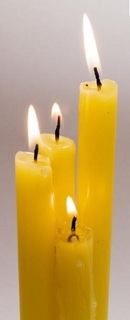 It
was on this day in 1946 that the first wagon set out from Budaörs [Ed: now a suburb west
of and adjacent to Budapest], which marked the beginning of the deportation of the
German minorities living in Hungary. On the occasion of the Memorial Day, Minister of Human
Resources Zoltán Balog and Imre Ritter, President of the Pest County German
Self-Government, will deliver speeches at 11.00 a.m. on Saturday at the Deportation
Memorial in Solymár’s Church Square (Templom tér) [Ed: Solymár is also a suburb just
north of Budaörs]. The Government awaits everyone who wishes to light candles of
remembrance in memory of the deportation of the Germans in Hungary.
It
was on this day in 1946 that the first wagon set out from Budaörs [Ed: now a suburb west
of and adjacent to Budapest], which marked the beginning of the deportation of the
German minorities living in Hungary. On the occasion of the Memorial Day, Minister of Human
Resources Zoltán Balog and Imre Ritter, President of the Pest County German
Self-Government, will deliver speeches at 11.00 a.m. on Saturday at the Deportation
Memorial in Solymár’s Church Square (Templom tér) [Ed: Solymár is also a suburb just
north of Budaörs]. The Government awaits everyone who wishes to light candles of
remembrance in memory of the deportation of the Germans in Hungary.
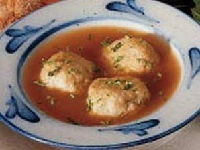 You
need 3 cans of beef broth or stock.
You
need 3 cans of beef broth or stock.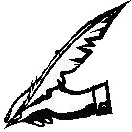 Genealogical
Quotes for your consideration:
Genealogical
Quotes for your consideration: